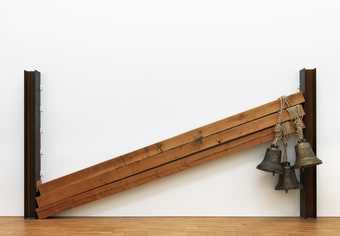
Jannis Kounellis, Bells 1993. ARTIST ROOMS Tate and National Galleries of Scotland. © Jannis Kounellis.
ARTIST ROOMS: Jannis Kounellis
Jannis Kounellis turns familiar materials, charged with history and meaning, into poetic assemblages
Jannis Kounellis (1936–2017) was born in the Greek port city of Piraeus, but lived and worked in Rome from 1956. His early paintings were inspired by words and graphics found in street signs, which he gradually reduced to letters, numbers and basic symbols arranged over plain backgrounds. Though he soon expanded his practice to include performance and sculpture, he considered himself primarily a painter. Whether making pictures or using materials and objects that share the same space as us as viewers, he aimed to create powerful images, mundane and strange at the same time.
In the late 1960s Kounellis became a key figure of the Italian arte povera (‘poor art’) movement. Artists associated with arte povera used ordinary materials of both natural and industrial origins and hoped to bring the experience of art closer to everyday life. At the time, Italy was undergoing a period of rapid social change, torn between industrial and agrarian life, tradition and innovation, antiquity and modernity. Kounellis’s works express this clash of values by bringing together contrasting elements such as raw wood and steel beams, or strings of colourful glass hanging next to a mound of black coal.
Many of Kounellis’s installations subtly change the architecture of the gallery, like the stones blocking the passage between two rooms. Some suggest the presence and actions of people: in a work bringing together painting, sculpture and performance, an empty chair lies waiting for a cellist to play a painted musical score. Other works carry strong associations both sensorial and cultural, like those including bells and coffee beans. These objects have a rich history, evoking sounds and smells familiar to many.
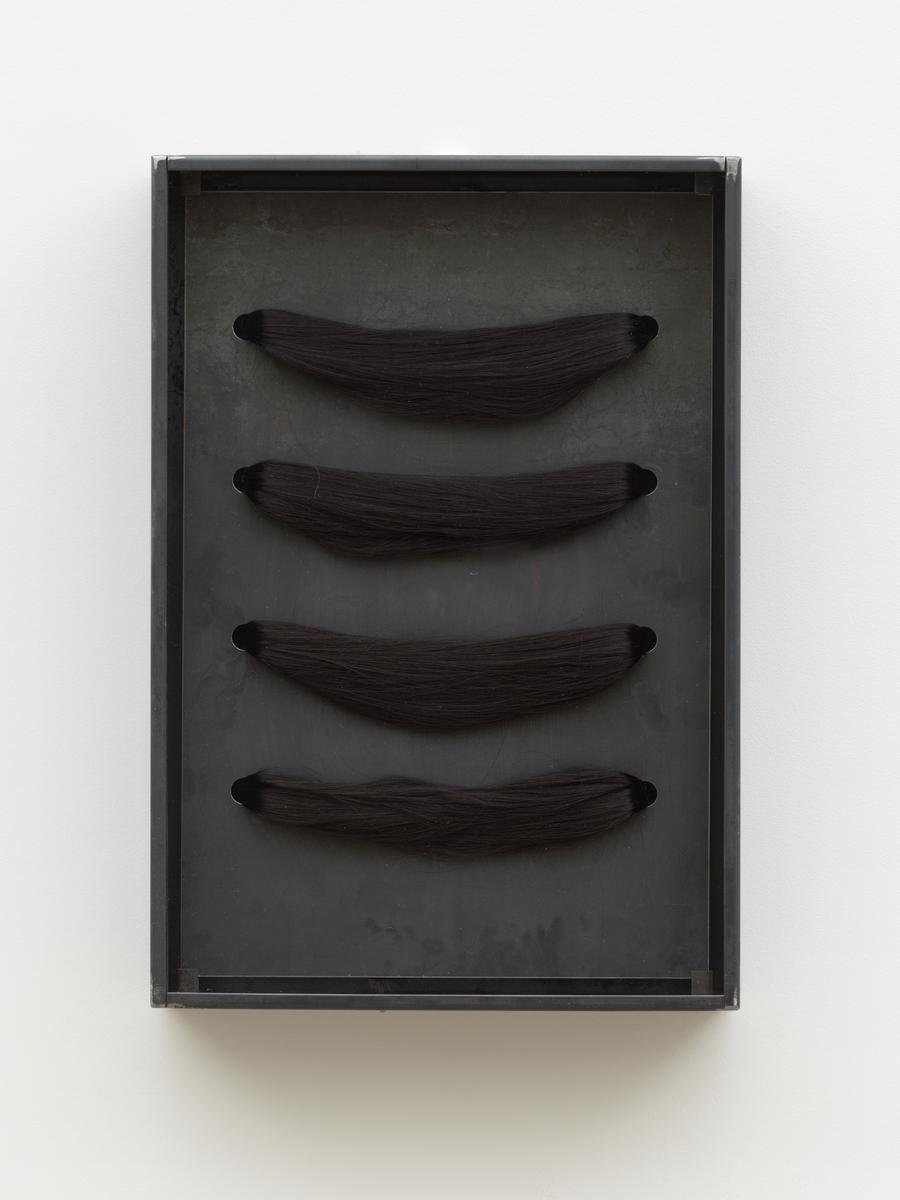
Jannis Kounellis, Untitled (Hair) 2004
Untitled (Hair) 2004 is a wall-mounted work that consists of a portrait-orientated steel box in which four hanks of long, black human hair are arranged. The shallow, glass-fronted box is displayed upright on the wall and contains a flat steel panel into which have been punched eight holes in two columns – one set of four towards the left side of the panel and the other set of four towards the right. The hanks of hair have been threaded through these holes so that they hang horizontally across the steel panel, appearing roughly parallel to one another in four curved lines.
1/29
artworks in ARTIST ROOMS: Jannis Kounellis
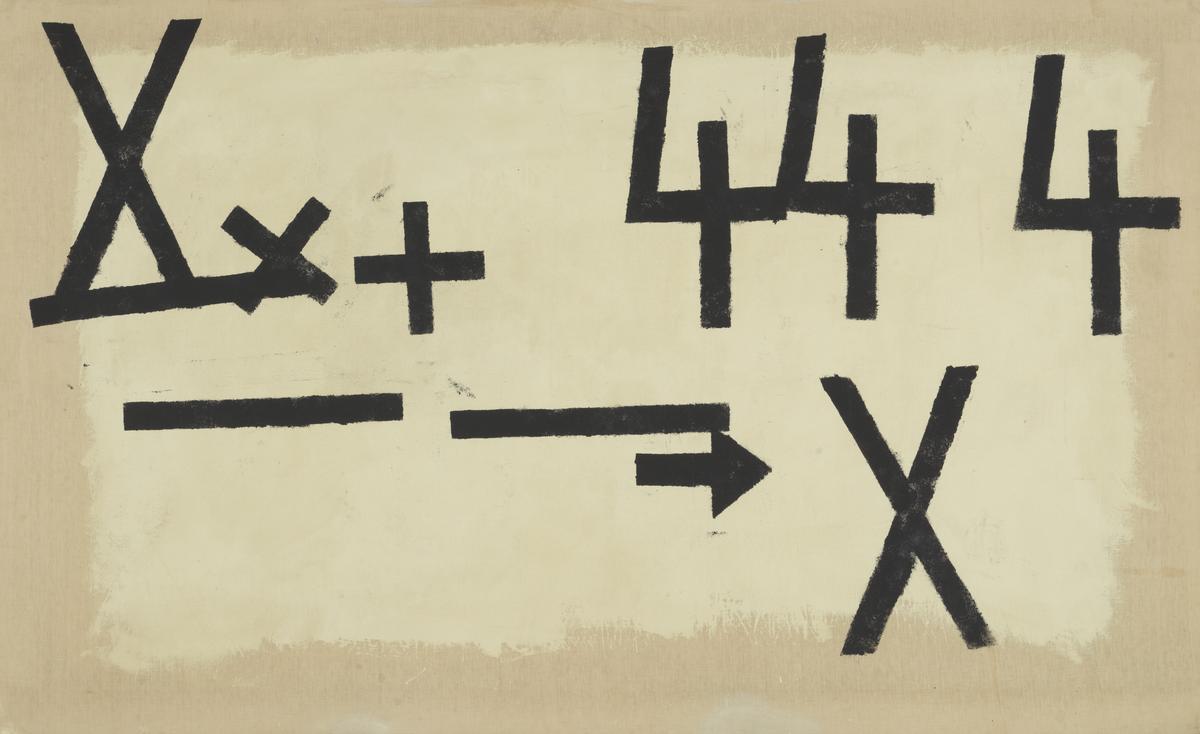
Jannis Kounellis, Untitled 1960
Untitled 1960 is a landscape-format painting on canvas. A rough-edged, off-white rectangle sits at the centre of the image bordered by a raw canvas edge with several signs and numbers stencilled on the surface in black paint. The text dominates the top portion of the canvas. It could be read like a mathematical formula as: ‘X x 44 4’, with the first two ‘X’ shapes underlined. However, the signs do not sit on even ground; the two X’s seem unbalanced on their linear platform, with the smaller of the two appearing to tip over. Likewise the numbers of the right-hand side are not evenly spaced, two brush up against one another, while the other is isolated. Two horizontal lines painted below this are stepped, and in the lower right-hand corner a small arrow points to another large ‘X’.
2/29
artworks in ARTIST ROOMS: Jannis Kounellis
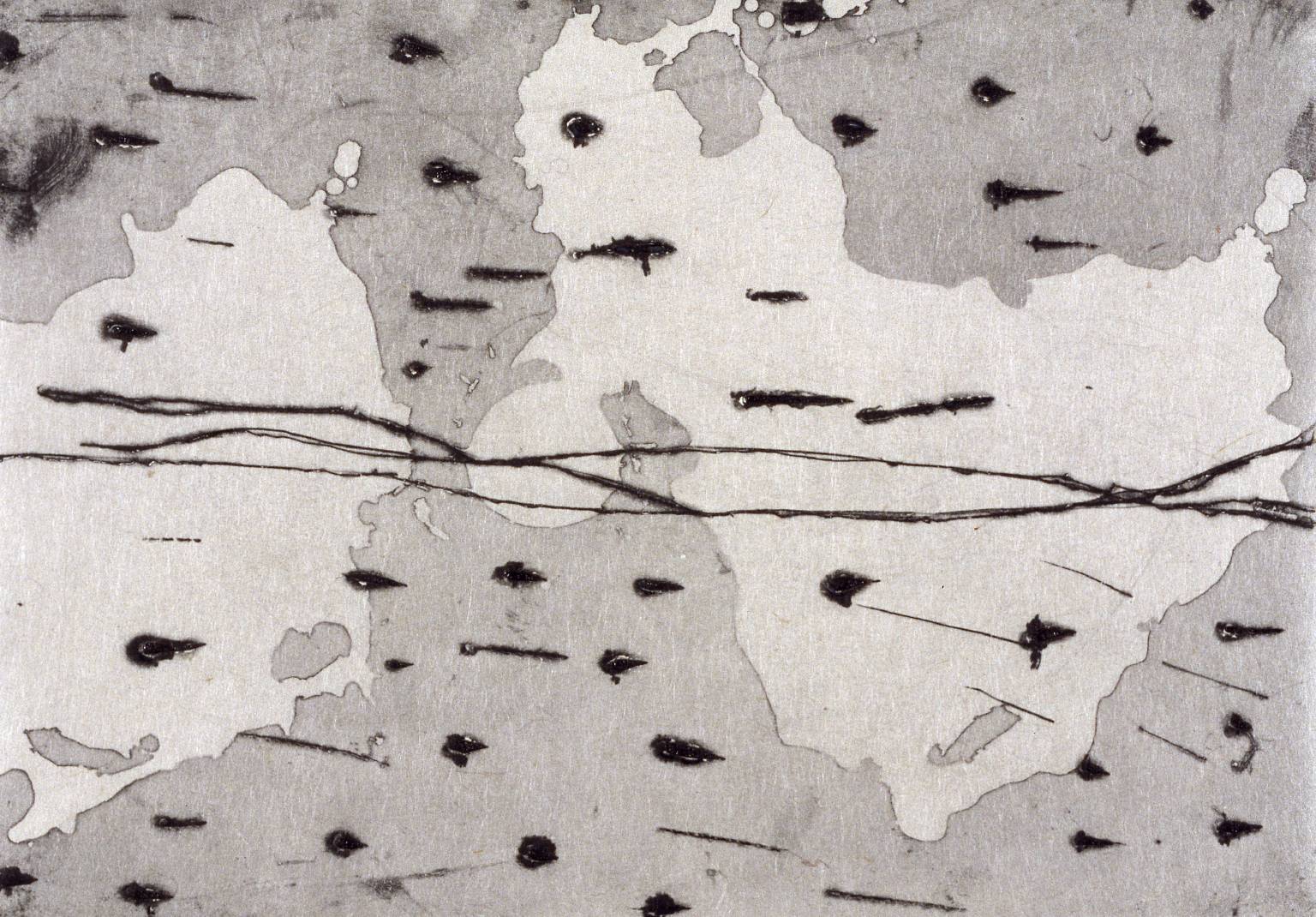
Jannis Kounellis, [no title] 1999
This etching is part of a portfolio of twelve abstract prints in an edition of twenty-one, of which this set is number twenty. Numbers one to ten have been bound; eleven to twenty-one are boxed loose portfolios. There are also five sets of artist's proofs. This text discusses the group of twelve works (P78423-P78434) as a whole. The plates were made in January 1999 in Kounellis' Roman studio using techniques which include softground etching, drypoint and aquatint as well as materials familiar from other areas of Kounellis' work, such as molten lead and wax, human hair, broken glass, coal and salt. The result is a series of twelve small, seductive abstract images, where delicate aquatinting is combined with marks, slashes, lumps and sharp lines which hint at the materials used (very literally in the case of P78433, where the artist has written the word 'piombo' - 'lead' - to indicate the nature of the abstract splotches above it) or, occasionally, at their maker (whose fingerprints can be seen on P78430 and P78434). The etchings were printed by the publisher, Jacob Samuel of Santa Monica, California, on Fabriano Tiepolo paper and natural Gampi. Gampi is a very fine Japanese paper which is placed between paper and plate at the time of printing and gives a rich, translucent finish to the resulting image. A short text by the artist prefaces the portfolio. Originally published in the journal Domus in 1982, it is repeated here in two languages, Italian and English, and describes an artist explaining to a jury his reasons for moving a figure from an unspecified print by Giovanni Battista Piranesi (1720-1778, the eighteenth-century Italian artist famous for his architectural engravings which depicted views of Rome) from the background to the foreground without changing the landscape. There follows a discussion about language, which has shifted from universal to a de-centred status, and the artist's need for a language which would allow him to enlarge the figure, in spite of his friends' warning that this would constitute an 'eversive act'. A courtroom verdict, given in the final lines of the text, finds the transgressor condemned to the life of a 'Wandering Jew', although the last line is given to the voice of a 'little old woman' who encourages the artist in his search which, she assures him, is 'the road to glory'. There appears to be no close connection between the text and the images. Giorgia BottinelliJanuary 2002 Further reading:Jannis Kounellis, 'Kounellis Brought to Trial', Domus, no.628, May 1982, pp.84-5.
3/29
artworks in ARTIST ROOMS: Jannis Kounellis
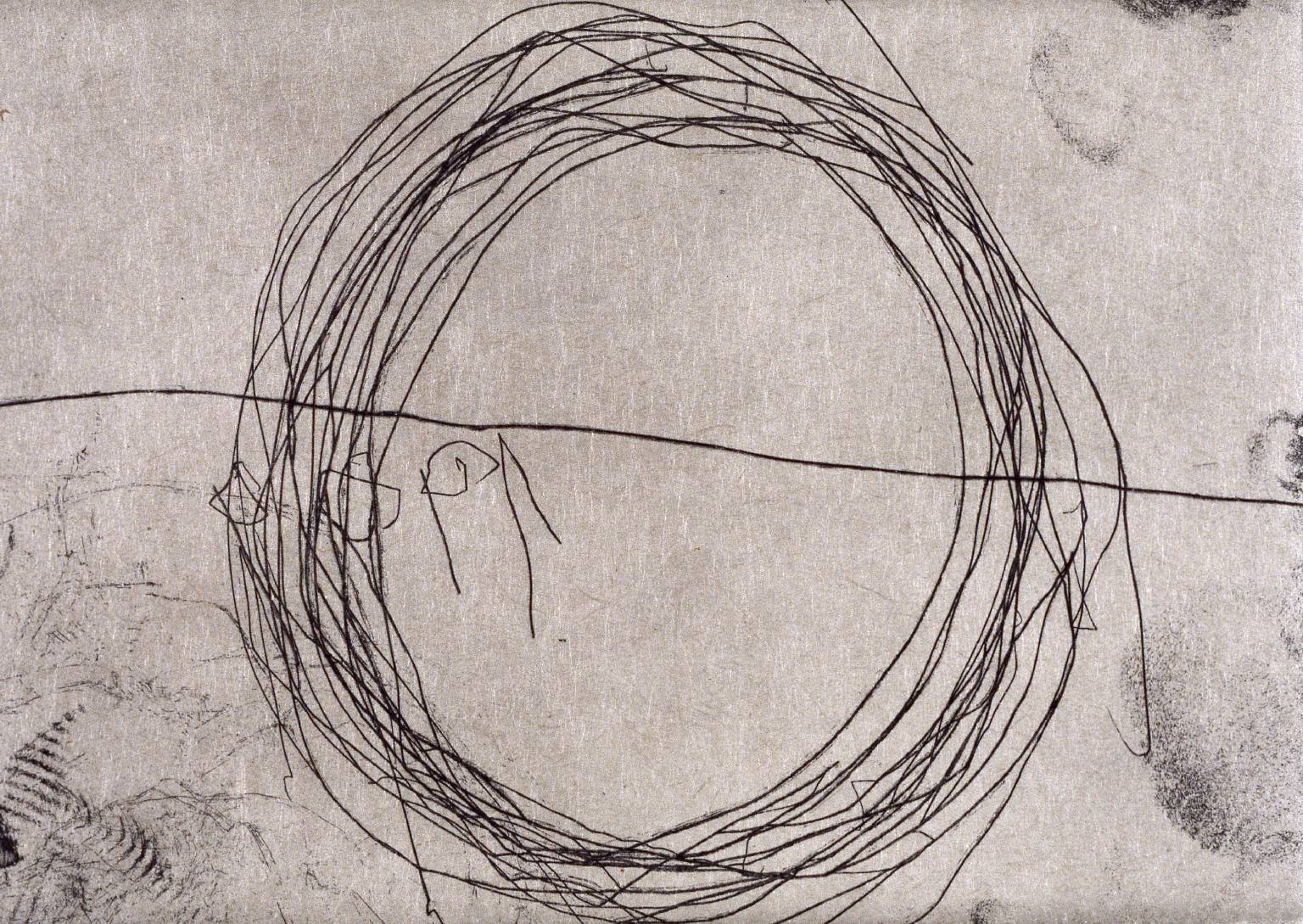
Jannis Kounellis, [no title] 1999
This etching is part of a portfolio of twelve abstract prints in an edition of twenty-one, of which this set is number twenty. Numbers one to ten have been bound; eleven to twenty-one are boxed loose portfolios. There are also five sets of artist's proofs. This text discusses the group of twelve works (P78423-P78434) as a whole. The plates were made in January 1999 in Kounellis' Roman studio using techniques which include softground etching, drypoint and aquatint as well as materials familiar from other areas of Kounellis' work, such as molten lead and wax, human hair, broken glass, coal and salt. The result is a series of twelve small, seductive abstract images, where delicate aquatinting is combined with marks, slashes, lumps and sharp lines which hint at the materials used (very literally in the case of P78433, where the artist has written the word 'piombo' - 'lead' - to indicate the nature of the abstract splotches above it) or, occasionally, at their maker (whose fingerprints can be seen on P78430 and P78434). The etchings were printed by the publisher, Jacob Samuel of Santa Monica, California, on Fabriano Tiepolo paper and natural Gampi. Gampi is a very fine Japanese paper which is placed between paper and plate at the time of printing and gives a rich, translucent finish to the resulting image. A short text by the artist prefaces the portfolio. Originally published in the journal Domus in 1982, it is repeated here in two languages, Italian and English, and describes an artist explaining to a jury his reasons for moving a figure from an unspecified print by Giovanni Battista Piranesi (1720-1778, the eighteenth-century Italian artist famous for his architectural engravings which depicted views of Rome) from the background to the foreground without changing the landscape. There follows a discussion about language, which has shifted from universal to a de-centred status, and the artist's need for a language which would allow him to enlarge the figure, in spite of his friends' warning that this would constitute an 'eversive act'. A courtroom verdict, given in the final lines of the text, finds the transgressor condemned to the life of a 'Wandering Jew', although the last line is given to the voice of a 'little old woman' who encourages the artist in his search which, she assures him, is 'the road to glory'. There appears to be no close connection between the text and the images. Giorgia BottinelliJanuary 2002 Further reading:Jannis Kounellis, 'Kounellis Brought to Trial', Domus, no.628, May 1982, pp.84-5.
4/29
artworks in ARTIST ROOMS: Jannis Kounellis
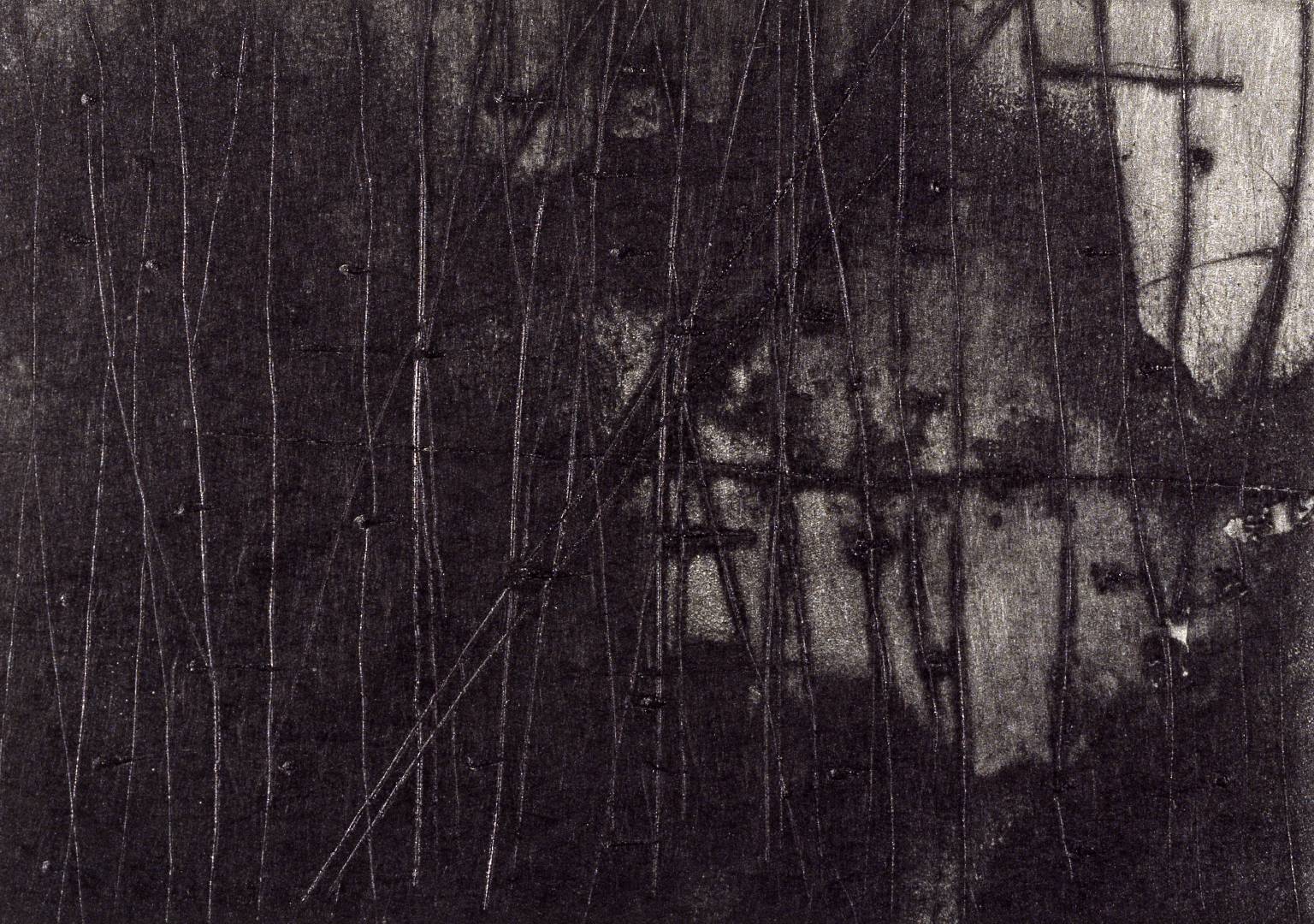
Jannis Kounellis, [no title] 1999
This etching is part of a portfolio of twelve abstract prints in an edition of twenty-one, of which this set is number twenty. Numbers one to ten have been bound; eleven to twenty-one are boxed loose portfolios. There are also five sets of artist's proofs. This text discusses the group of twelve works (P78423-P78434) as a whole. The plates were made in January 1999 in Kounellis' Roman studio using techniques which include softground etching, drypoint and aquatint as well as materials familiar from other areas of Kounellis' work, such as molten lead and wax, human hair, broken glass, coal and salt. The result is a series of twelve small, seductive abstract images, where delicate aquatinting is combined with marks, slashes, lumps and sharp lines which hint at the materials used (very literally in the case of P78433, where the artist has written the word 'piombo' - 'lead' - to indicate the nature of the abstract splotches above it) or, occasionally, at their maker (whose fingerprints can be seen on P78430 and P78434). The etchings were printed by the publisher, Jacob Samuel of Santa Monica, California, on Fabriano Tiepolo paper and natural Gampi. Gampi is a very fine Japanese paper which is placed between paper and plate at the time of printing and gives a rich, translucent finish to the resulting image. A short text by the artist prefaces the portfolio. Originally published in the journal Domus in 1982, it is repeated here in two languages, Italian and English, and describes an artist explaining to a jury his reasons for moving a figure from an unspecified print by Giovanni Battista Piranesi (1720-1778, the eighteenth-century Italian artist famous for his architectural engravings which depicted views of Rome) from the background to the foreground without changing the landscape. There follows a discussion about language, which has shifted from universal to a de-centred status, and the artist's need for a language which would allow him to enlarge the figure, in spite of his friends' warning that this would constitute an 'eversive act'. A courtroom verdict, given in the final lines of the text, finds the transgressor condemned to the life of a 'Wandering Jew', although the last line is given to the voice of a 'little old woman' who encourages the artist in his search which, she assures him, is 'the road to glory'. There appears to be no close connection between the text and the images. Giorgia BottinelliJanuary 2002 Further reading:Jannis Kounellis, 'Kounellis Brought to Trial', Domus, no.628, May 1982, pp.84-5.
5/29
artworks in ARTIST ROOMS: Jannis Kounellis

Jannis Kounellis, [no title] 1999
This etching is part of a portfolio of twelve abstract prints in an edition of twenty-one, of which this set is number twenty. Numbers one to ten have been bound; eleven to twenty-one are boxed loose portfolios. There are also five sets of artist's proofs. This text discusses the group of twelve works (P78423-P78434) as a whole. The plates were made in January 1999 in Kounellis' Roman studio using techniques which include softground etching, drypoint and aquatint as well as materials familiar from other areas of Kounellis' work, such as molten lead and wax, human hair, broken glass, coal and salt. The result is a series of twelve small, seductive abstract images, where delicate aquatinting is combined with marks, slashes, lumps and sharp lines which hint at the materials used (very literally in the case of P78433, where the artist has written the word 'piombo' - 'lead' - to indicate the nature of the abstract splotches above it) or, occasionally, at their maker (whose fingerprints can be seen on P78430 and P78434). The etchings were printed by the publisher, Jacob Samuel of Santa Monica, California, on Fabriano Tiepolo paper and natural Gampi. Gampi is a very fine Japanese paper which is placed between paper and plate at the time of printing and gives a rich, translucent finish to the resulting image. A short text by the artist prefaces the portfolio. Originally published in the journal Domus in 1982, it is repeated here in two languages, Italian and English, and describes an artist explaining to a jury his reasons for moving a figure from an unspecified print by Giovanni Battista Piranesi (1720-1778, the eighteenth-century Italian artist famous for his architectural engravings which depicted views of Rome) from the background to the foreground without changing the landscape. There follows a discussion about language, which has shifted from universal to a de-centred status, and the artist's need for a language which would allow him to enlarge the figure, in spite of his friends' warning that this would constitute an 'eversive act'. A courtroom verdict, given in the final lines of the text, finds the transgressor condemned to the life of a 'Wandering Jew', although the last line is given to the voice of a 'little old woman' who encourages the artist in his search which, she assures him, is 'the road to glory'. There appears to be no close connection between the text and the images. Giorgia BottinelliJanuary 2002 Further reading:Jannis Kounellis, 'Kounellis Brought to Trial', Domus, no.628, May 1982, pp.84-5.
6/29
artworks in ARTIST ROOMS: Jannis Kounellis
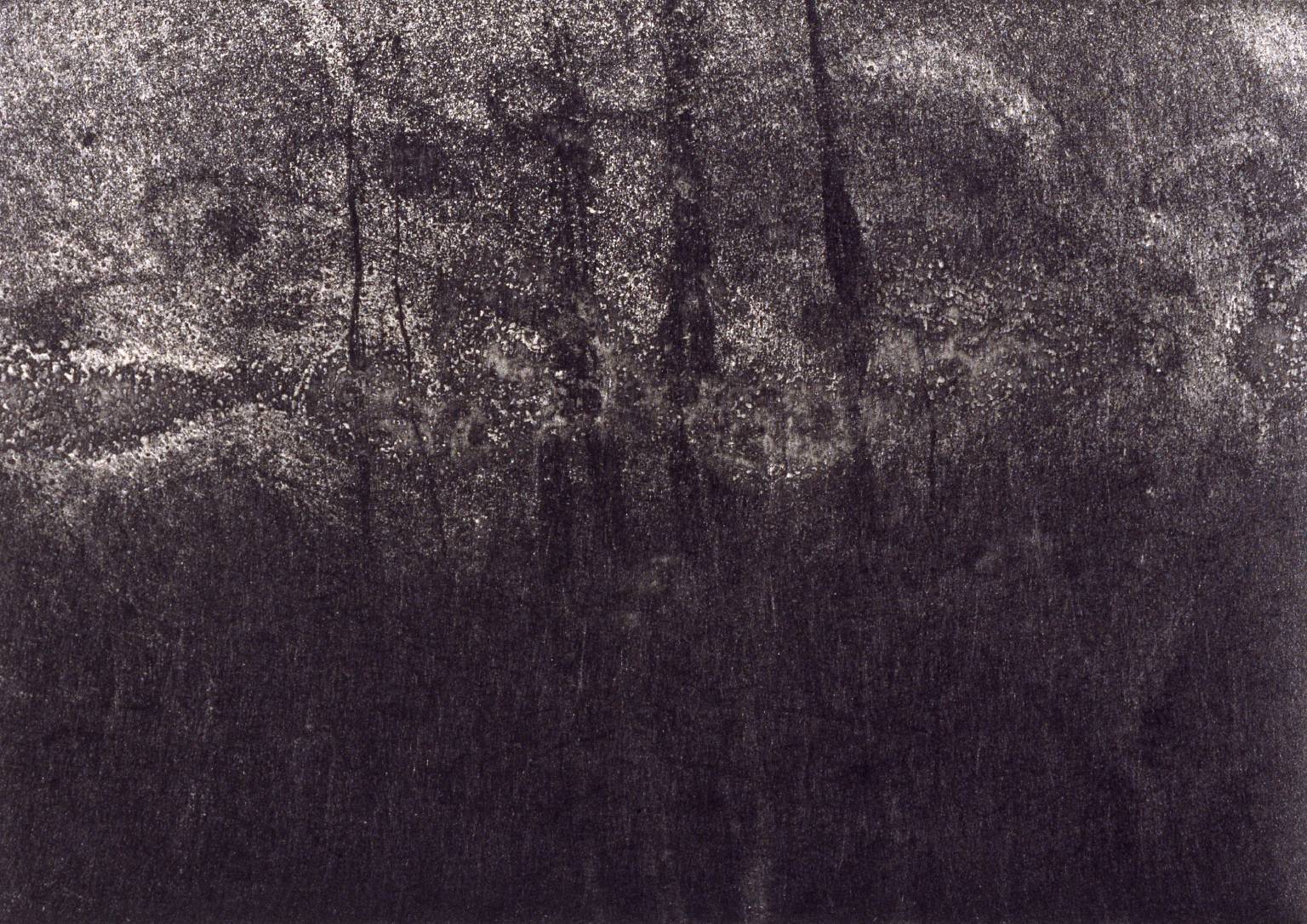
Jannis Kounellis, [no title] 1999
This etching is part of a portfolio of twelve abstract prints in an edition of twenty-one, of which this set is number twenty. Numbers one to ten have been bound; eleven to twenty-one are boxed loose portfolios. There are also five sets of artist's proofs. This text discusses the group of twelve works (P78423-P78434) as a whole. The plates were made in January 1999 in Kounellis' Roman studio using techniques which include softground etching, drypoint and aquatint as well as materials familiar from other areas of Kounellis' work, such as molten lead and wax, human hair, broken glass, coal and salt. The result is a series of twelve small, seductive abstract images, where delicate aquatinting is combined with marks, slashes, lumps and sharp lines which hint at the materials used (very literally in the case of P78433, where the artist has written the word 'piombo' - 'lead' - to indicate the nature of the abstract splotches above it) or, occasionally, at their maker (whose fingerprints can be seen on P78430 and P78434). The etchings were printed by the publisher, Jacob Samuel of Santa Monica, California, on Fabriano Tiepolo paper and natural Gampi. Gampi is a very fine Japanese paper which is placed between paper and plate at the time of printing and gives a rich, translucent finish to the resulting image. A short text by the artist prefaces the portfolio. Originally published in the journal Domus in 1982, it is repeated here in two languages, Italian and English, and describes an artist explaining to a jury his reasons for moving a figure from an unspecified print by Giovanni Battista Piranesi (1720-1778, the eighteenth-century Italian artist famous for his architectural engravings which depicted views of Rome) from the background to the foreground without changing the landscape. There follows a discussion about language, which has shifted from universal to a de-centred status, and the artist's need for a language which would allow him to enlarge the figure, in spite of his friends' warning that this would constitute an 'eversive act'. A courtroom verdict, given in the final lines of the text, finds the transgressor condemned to the life of a 'Wandering Jew', although the last line is given to the voice of a 'little old woman' who encourages the artist in his search which, she assures him, is 'the road to glory'. There appears to be no close connection between the text and the images. Giorgia BottinelliJanuary 2002 Further reading:Jannis Kounellis, 'Kounellis Brought to Trial', Domus, no.628, May 1982, pp.84-5.
7/29
artworks in ARTIST ROOMS: Jannis Kounellis
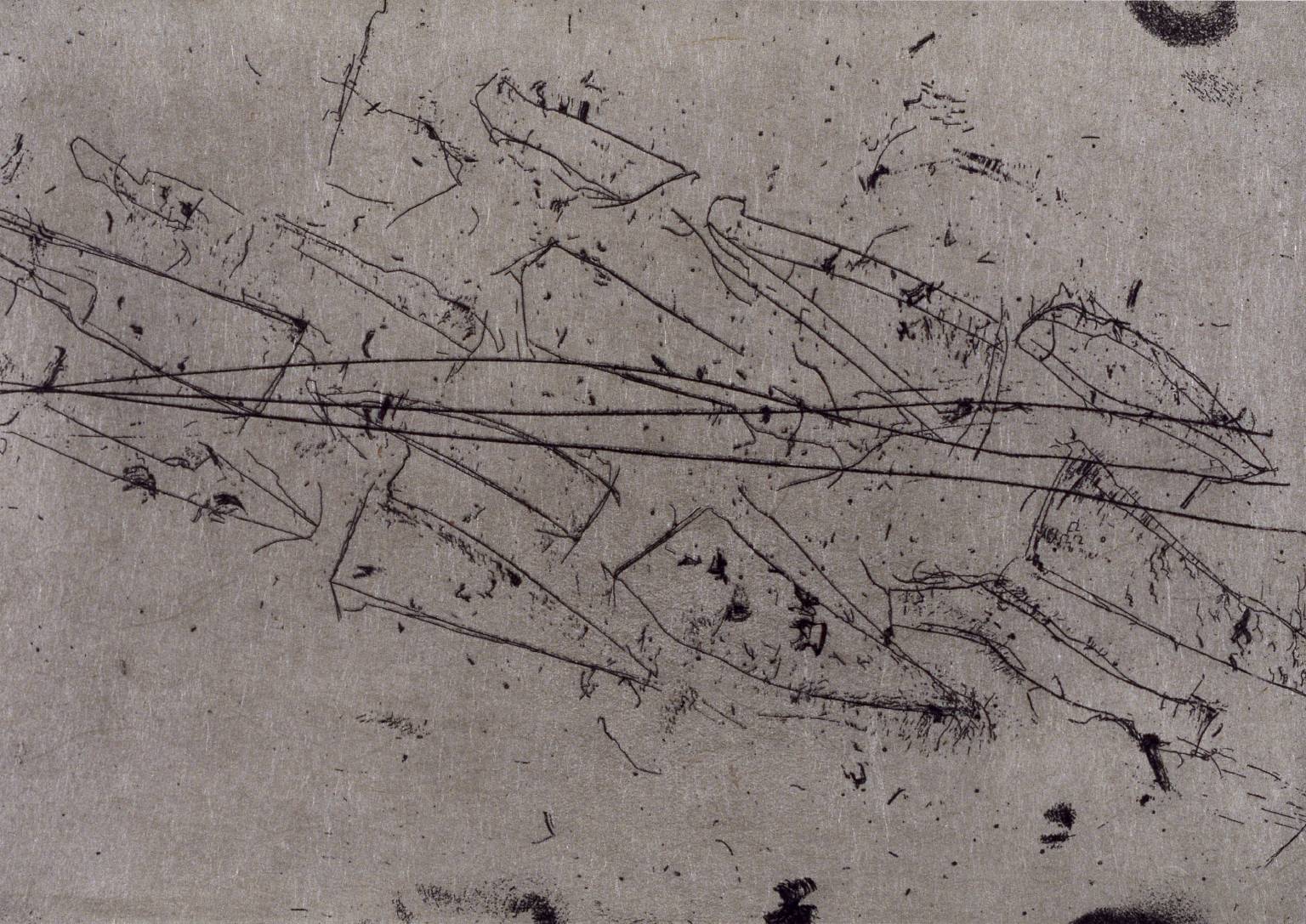
Jannis Kounellis, [no title] 1999
This etching is part of a portfolio of twelve abstract prints in an edition of twenty-one, of which this set is number twenty. Numbers one to ten have been bound; eleven to twenty-one are boxed loose portfolios. There are also five sets of artist's proofs. This text discusses the group of twelve works (P78423-P78434) as a whole. The plates were made in January 1999 in Kounellis' Roman studio using techniques which include softground etching, drypoint and aquatint as well as materials familiar from other areas of Kounellis' work, such as molten lead and wax, human hair, broken glass, coal and salt. The result is a series of twelve small, seductive abstract images, where delicate aquatinting is combined with marks, slashes, lumps and sharp lines which hint at the materials used (very literally in the case of P78433, where the artist has written the word 'piombo' - 'lead' - to indicate the nature of the abstract splotches above it) or, occasionally, at their maker (whose fingerprints can be seen on P78430 and P78434). The etchings were printed by the publisher, Jacob Samuel of Santa Monica, California, on Fabriano Tiepolo paper and natural Gampi. Gampi is a very fine Japanese paper which is placed between paper and plate at the time of printing and gives a rich, translucent finish to the resulting image. A short text by the artist prefaces the portfolio. Originally published in the journal Domus in 1982, it is repeated here in two languages, Italian and English, and describes an artist explaining to a jury his reasons for moving a figure from an unspecified print by Giovanni Battista Piranesi (1720-1778, the eighteenth-century Italian artist famous for his architectural engravings which depicted views of Rome) from the background to the foreground without changing the landscape. There follows a discussion about language, which has shifted from universal to a de-centred status, and the artist's need for a language which would allow him to enlarge the figure, in spite of his friends' warning that this would constitute an 'eversive act'. A courtroom verdict, given in the final lines of the text, finds the transgressor condemned to the life of a 'Wandering Jew', although the last line is given to the voice of a 'little old woman' who encourages the artist in his search which, she assures him, is 'the road to glory'. There appears to be no close connection between the text and the images. Giorgia BottinelliJanuary 2002 Further reading:Jannis Kounellis, 'Kounellis Brought to Trial', Domus, no.628, May 1982, pp.84-5.
8/29
artworks in ARTIST ROOMS: Jannis Kounellis
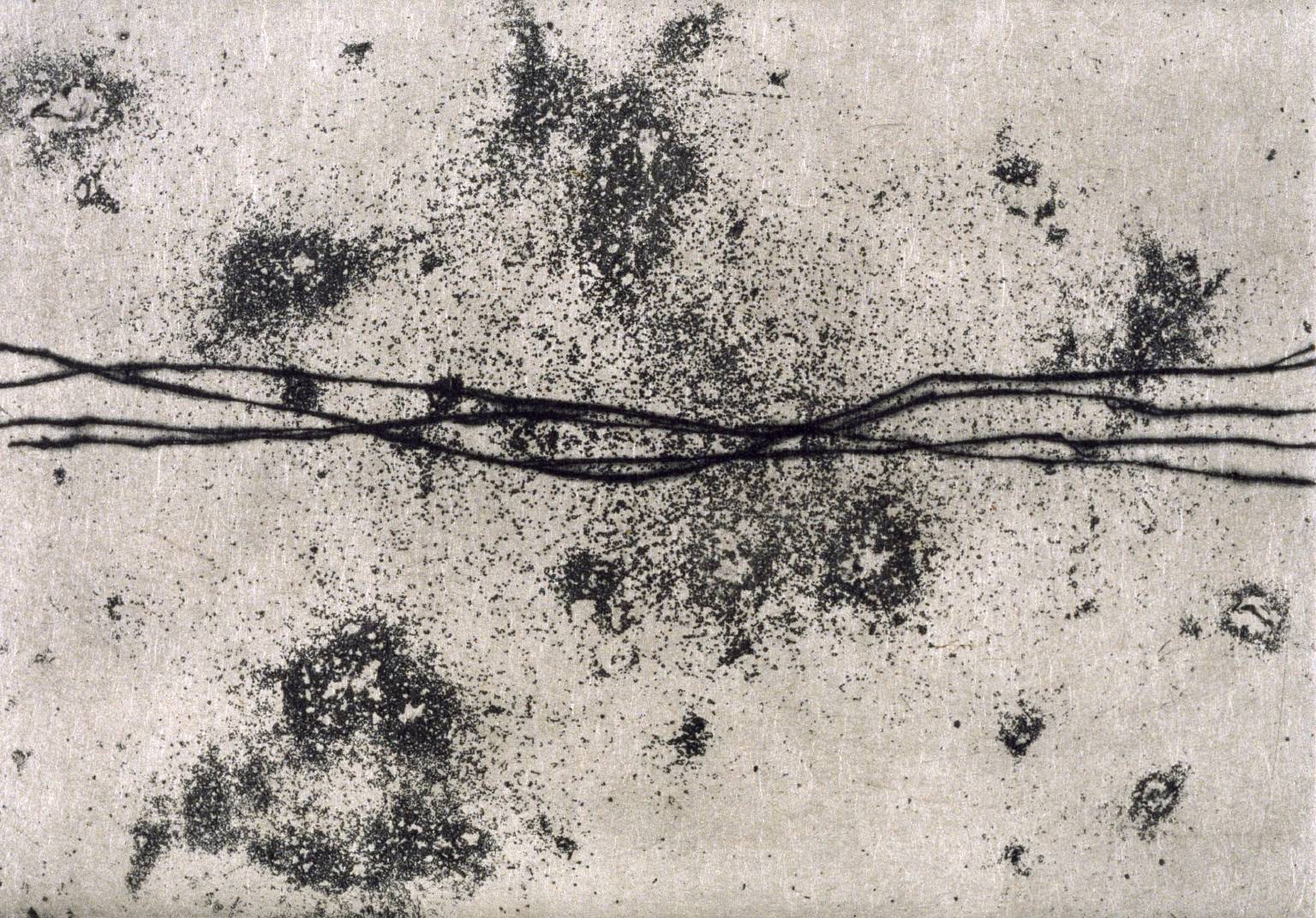
Jannis Kounellis, [no title] 1999
This etching is part of a portfolio of twelve abstract prints in an edition of twenty-one, of which this set is number twenty. Numbers one to ten have been bound; eleven to twenty-one are boxed loose portfolios. There are also five sets of artist's proofs. This text discusses the group of twelve works (P78423-P78434) as a whole. The plates were made in January 1999 in Kounellis' Roman studio using techniques which include softground etching, drypoint and aquatint as well as materials familiar from other areas of Kounellis' work, such as molten lead and wax, human hair, broken glass, coal and salt. The result is a series of twelve small, seductive abstract images, where delicate aquatinting is combined with marks, slashes, lumps and sharp lines which hint at the materials used (very literally in the case of P78433, where the artist has written the word 'piombo' - 'lead' - to indicate the nature of the abstract splotches above it) or, occasionally, at their maker (whose fingerprints can be seen on P78430 and P78434). The etchings were printed by the publisher, Jacob Samuel of Santa Monica, California, on Fabriano Tiepolo paper and natural Gampi. Gampi is a very fine Japanese paper which is placed between paper and plate at the time of printing and gives a rich, translucent finish to the resulting image. A short text by the artist prefaces the portfolio. Originally published in the journal Domus in 1982, it is repeated here in two languages, Italian and English, and describes an artist explaining to a jury his reasons for moving a figure from an unspecified print by Giovanni Battista Piranesi (1720-1778, the eighteenth-century Italian artist famous for his architectural engravings which depicted views of Rome) from the background to the foreground without changing the landscape. There follows a discussion about language, which has shifted from universal to a de-centred status, and the artist's need for a language which would allow him to enlarge the figure, in spite of his friends' warning that this would constitute an 'eversive act'. A courtroom verdict, given in the final lines of the text, finds the transgressor condemned to the life of a 'Wandering Jew', although the last line is given to the voice of a 'little old woman' who encourages the artist in his search which, she assures him, is 'the road to glory'. There appears to be no close connection between the text and the images. Giorgia BottinelliJanuary 2002 Further reading:Jannis Kounellis, 'Kounellis Brought to Trial', Domus, no.628, May 1982, pp.84-5.
9/29
artworks in ARTIST ROOMS: Jannis Kounellis
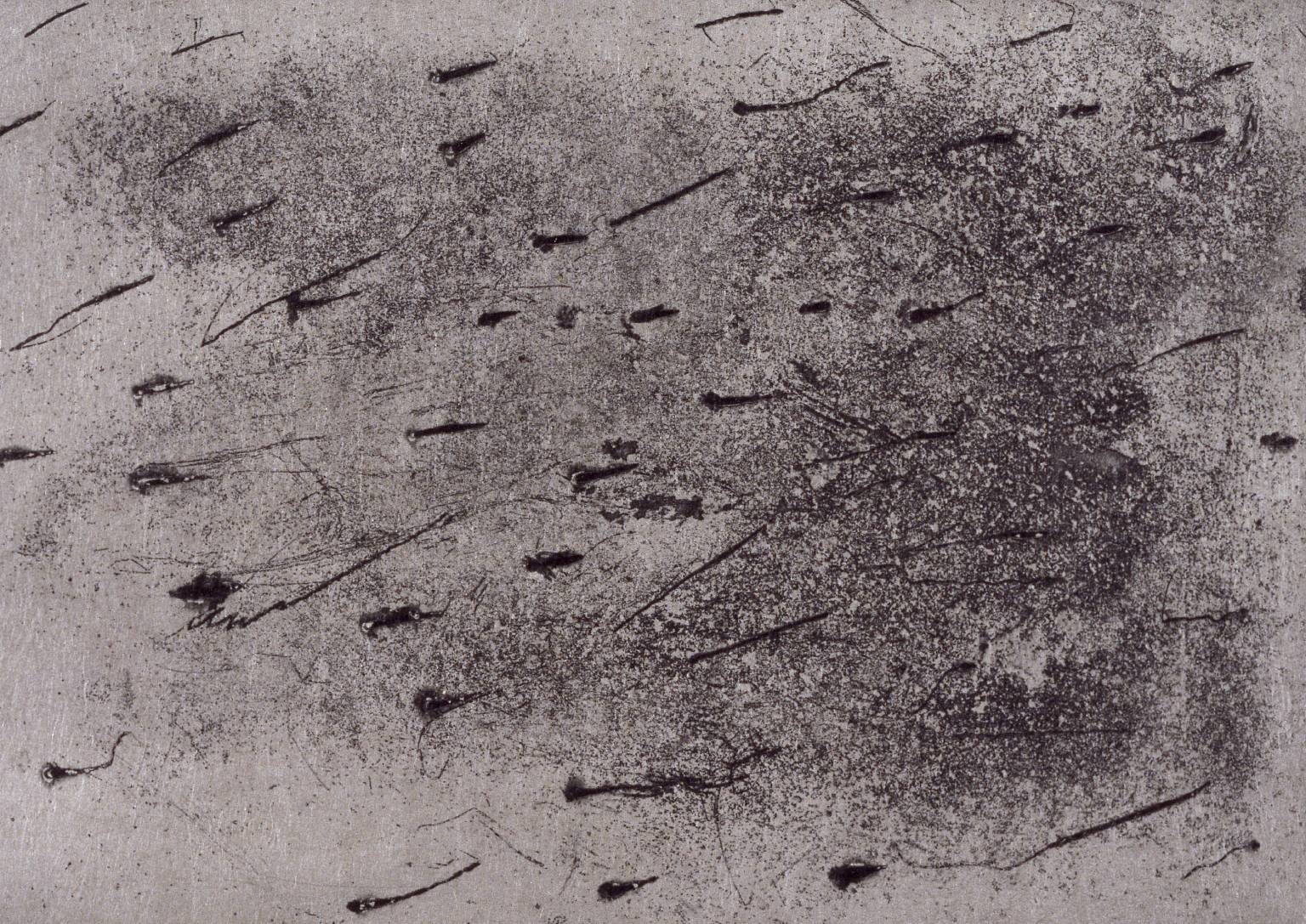
Jannis Kounellis, [no title] 1999
This etching is part of a portfolio of twelve abstract prints in an edition of twenty-one, of which this set is number twenty. Numbers one to ten have been bound; eleven to twenty-one are boxed loose portfolios. There are also five sets of artist's proofs. This text discusses the group of twelve works (P78423-P78434) as a whole. The plates were made in January 1999 in Kounellis' Roman studio using techniques which include softground etching, drypoint and aquatint as well as materials familiar from other areas of Kounellis' work, such as molten lead and wax, human hair, broken glass, coal and salt. The result is a series of twelve small, seductive abstract images, where delicate aquatinting is combined with marks, slashes, lumps and sharp lines which hint at the materials used (very literally in the case of P78433, where the artist has written the word 'piombo' - 'lead' - to indicate the nature of the abstract splotches above it) or, occasionally, at their maker (whose fingerprints can be seen on P78430 and P78434). The etchings were printed by the publisher, Jacob Samuel of Santa Monica, California, on Fabriano Tiepolo paper and natural Gampi. Gampi is a very fine Japanese paper which is placed between paper and plate at the time of printing and gives a rich, translucent finish to the resulting image. A short text by the artist prefaces the portfolio. Originally published in the journal Domus in 1982, it is repeated here in two languages, Italian and English, and describes an artist explaining to a jury his reasons for moving a figure from an unspecified print by Giovanni Battista Piranesi (1720-1778, the eighteenth-century Italian artist famous for his architectural engravings which depicted views of Rome) from the background to the foreground without changing the landscape. There follows a discussion about language, which has shifted from universal to a de-centred status, and the artist's need for a language which would allow him to enlarge the figure, in spite of his friends' warning that this would constitute an 'eversive act'. A courtroom verdict, given in the final lines of the text, finds the transgressor condemned to the life of a 'Wandering Jew', although the last line is given to the voice of a 'little old woman' who encourages the artist in his search which, she assures him, is 'the road to glory'. There appears to be no close connection between the text and the images. Giorgia BottinelliJanuary 2002 Further reading:Jannis Kounellis, 'Kounellis Brought to Trial', Domus, no.628, May 1982, pp.84-5.
10/29
artworks in ARTIST ROOMS: Jannis Kounellis
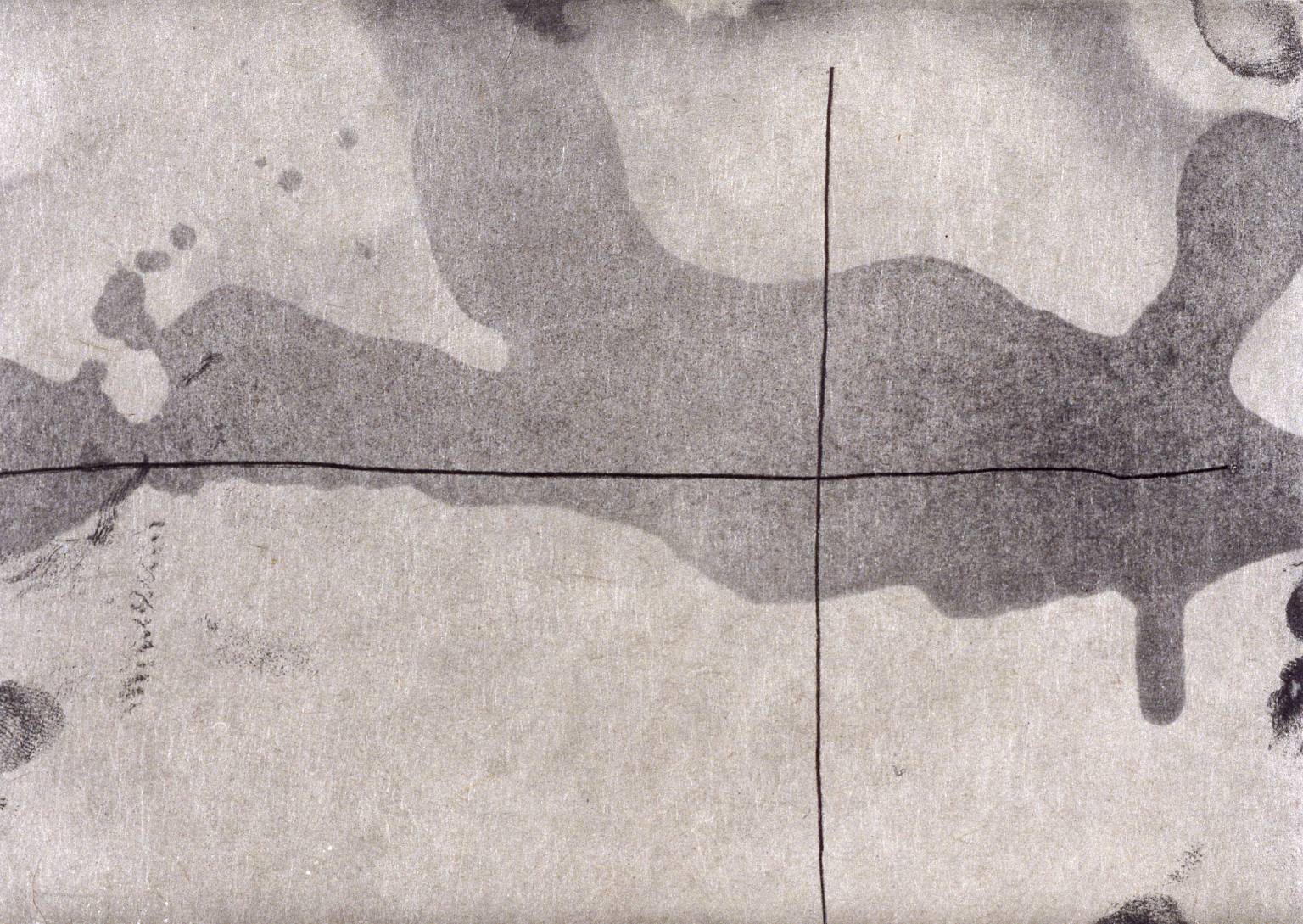
Jannis Kounellis, [no title] 1999
This etching is part of a portfolio of twelve abstract prints in an edition of twenty-one, of which this set is number twenty. Numbers one to ten have been bound; eleven to twenty-one are boxed loose portfolios. There are also five sets of artist's proofs. This text discusses the group of twelve works (P78423-P78434) as a whole. The plates were made in January 1999 in Kounellis' Roman studio using techniques which include softground etching, drypoint and aquatint as well as materials familiar from other areas of Kounellis' work, such as molten lead and wax, human hair, broken glass, coal and salt. The result is a series of twelve small, seductive abstract images, where delicate aquatinting is combined with marks, slashes, lumps and sharp lines which hint at the materials used (very literally in the case of P78433, where the artist has written the word 'piombo' - 'lead' - to indicate the nature of the abstract splotches above it) or, occasionally, at their maker (whose fingerprints can be seen on P78430 and P78434). The etchings were printed by the publisher, Jacob Samuel of Santa Monica, California, on Fabriano Tiepolo paper and natural Gampi. Gampi is a very fine Japanese paper which is placed between paper and plate at the time of printing and gives a rich, translucent finish to the resulting image. A short text by the artist prefaces the portfolio. Originally published in the journal Domus in 1982, it is repeated here in two languages, Italian and English, and describes an artist explaining to a jury his reasons for moving a figure from an unspecified print by Giovanni Battista Piranesi (1720-1778, the eighteenth-century Italian artist famous for his architectural engravings which depicted views of Rome) from the background to the foreground without changing the landscape. There follows a discussion about language, which has shifted from universal to a de-centred status, and the artist's need for a language which would allow him to enlarge the figure, in spite of his friends' warning that this would constitute an 'eversive act'. A courtroom verdict, given in the final lines of the text, finds the transgressor condemned to the life of a 'Wandering Jew', although the last line is given to the voice of a 'little old woman' who encourages the artist in his search which, she assures him, is 'the road to glory'. There appears to be no close connection between the text and the images. Giorgia BottinelliJanuary 2002 Further reading:Jannis Kounellis, 'Kounellis Brought to Trial', Domus, no.628, May 1982, pp.84-5.
11/29
artworks in ARTIST ROOMS: Jannis Kounellis
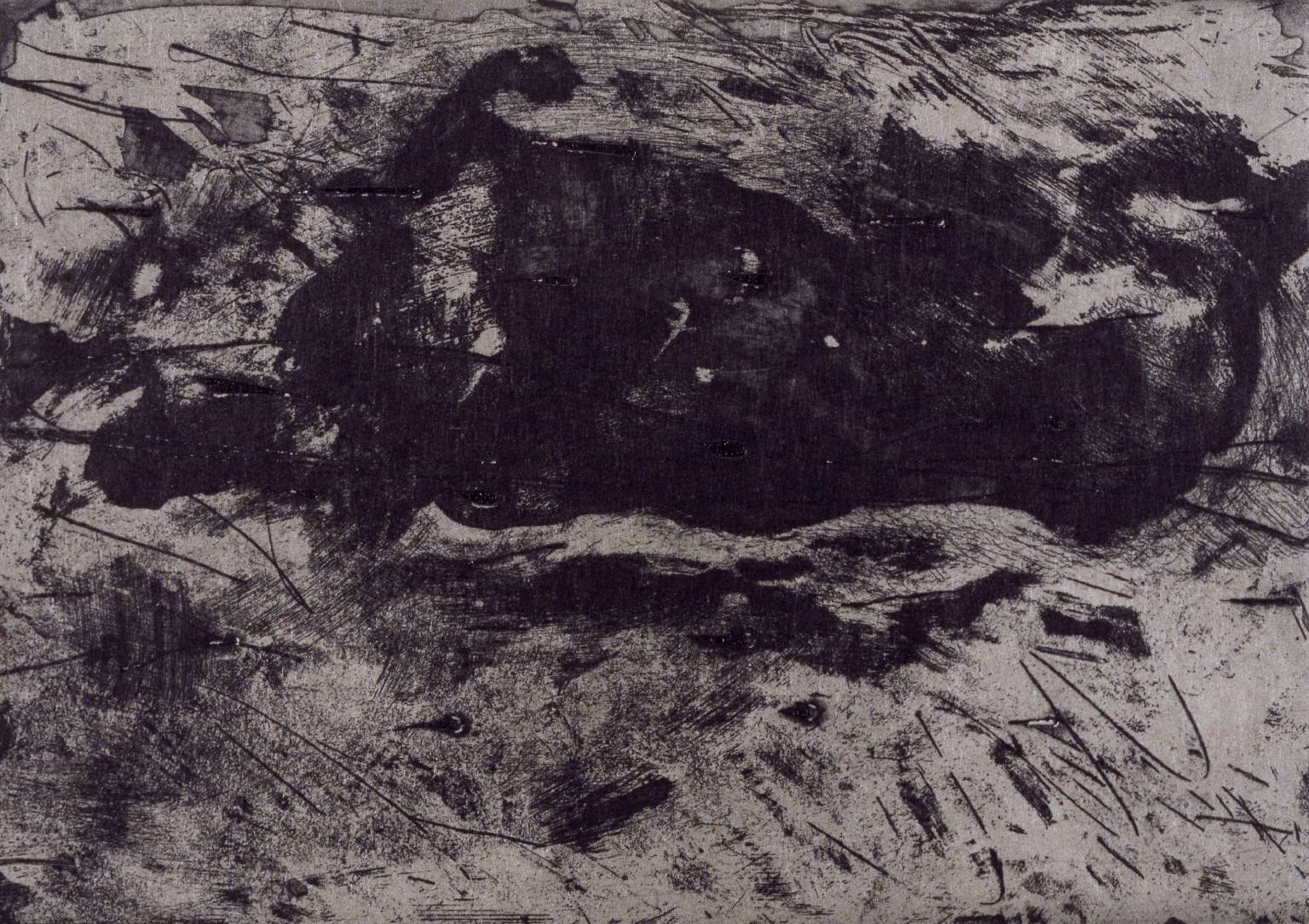
Jannis Kounellis, [no title] 1999
This etching is part of a portfolio of twelve abstract prints in an edition of twenty-one, of which this set is number twenty. Numbers one to ten have been bound; eleven to twenty-one are boxed loose portfolios. There are also five sets of artist's proofs. This text discusses the group of twelve works (P78423-P78434) as a whole. The plates were made in January 1999 in Kounellis' Roman studio using techniques which include softground etching, drypoint and aquatint as well as materials familiar from other areas of Kounellis' work, such as molten lead and wax, human hair, broken glass, coal and salt. The result is a series of twelve small, seductive abstract images, where delicate aquatinting is combined with marks, slashes, lumps and sharp lines which hint at the materials used (very literally in the case of P78433, where the artist has written the word 'piombo' - 'lead' - to indicate the nature of the abstract splotches above it) or, occasionally, at their maker (whose fingerprints can be seen on P78430 and P78434). The etchings were printed by the publisher, Jacob Samuel of Santa Monica, California, on Fabriano Tiepolo paper and natural Gampi. Gampi is a very fine Japanese paper which is placed between paper and plate at the time of printing and gives a rich, translucent finish to the resulting image. A short text by the artist prefaces the portfolio. Originally published in the journal Domus in 1982, it is repeated here in two languages, Italian and English, and describes an artist explaining to a jury his reasons for moving a figure from an unspecified print by Giovanni Battista Piranesi (1720-1778, the eighteenth-century Italian artist famous for his architectural engravings which depicted views of Rome) from the background to the foreground without changing the landscape. There follows a discussion about language, which has shifted from universal to a de-centred status, and the artist's need for a language which would allow him to enlarge the figure, in spite of his friends' warning that this would constitute an 'eversive act'. A courtroom verdict, given in the final lines of the text, finds the transgressor condemned to the life of a 'Wandering Jew', although the last line is given to the voice of a 'little old woman' who encourages the artist in his search which, she assures him, is 'the road to glory'. There appears to be no close connection between the text and the images. Giorgia BottinelliJanuary 2002 Further reading:Jannis Kounellis, 'Kounellis Brought to Trial', Domus, no.628, May 1982, pp.84-5.
12/29
artworks in ARTIST ROOMS: Jannis Kounellis
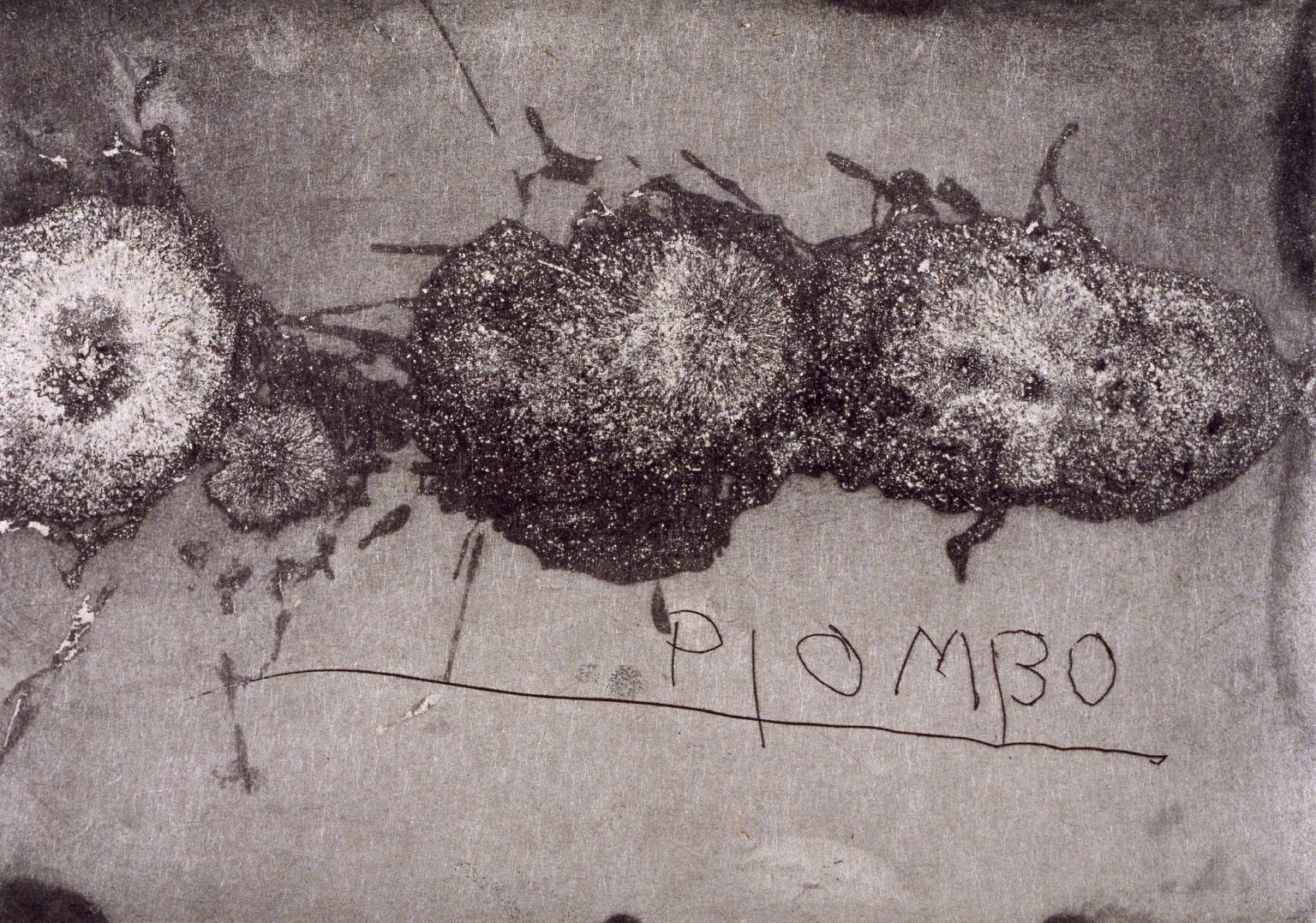
Jannis Kounellis, [no title] 1999
This etching is part of a portfolio of twelve abstract prints in an edition of twenty-one, of which this set is number twenty. Numbers one to ten have been bound; eleven to twenty-one are boxed loose portfolios. There are also five sets of artist's proofs. This text discusses the group of twelve works (P78423-P78434) as a whole. The plates were made in January 1999 in Kounellis' Roman studio using techniques which include softground etching, drypoint and aquatint as well as materials familiar from other areas of Kounellis' work, such as molten lead and wax, human hair, broken glass, coal and salt. The result is a series of twelve small, seductive abstract images, where delicate aquatinting is combined with marks, slashes, lumps and sharp lines which hint at the materials used (very literally in the case of P78433, where the artist has written the word 'piombo' - 'lead' - to indicate the nature of the abstract splotches above it) or, occasionally, at their maker (whose fingerprints can be seen on P78430 and P78434). The etchings were printed by the publisher, Jacob Samuel of Santa Monica, California, on Fabriano Tiepolo paper and natural Gampi. Gampi is a very fine Japanese paper which is placed between paper and plate at the time of printing and gives a rich, translucent finish to the resulting image. A short text by the artist prefaces the portfolio. Originally published in the journal Domus in 1982, it is repeated here in two languages, Italian and English, and describes an artist explaining to a jury his reasons for moving a figure from an unspecified print by Giovanni Battista Piranesi (1720-1778, the eighteenth-century Italian artist famous for his architectural engravings which depicted views of Rome) from the background to the foreground without changing the landscape. There follows a discussion about language, which has shifted from universal to a de-centred status, and the artist's need for a language which would allow him to enlarge the figure, in spite of his friends' warning that this would constitute an 'eversive act'. A courtroom verdict, given in the final lines of the text, finds the transgressor condemned to the life of a 'Wandering Jew', although the last line is given to the voice of a 'little old woman' who encourages the artist in his search which, she assures him, is 'the road to glory'. There appears to be no close connection between the text and the images. Giorgia BottinelliJanuary 2002 Further reading:Jannis Kounellis, 'Kounellis Brought to Trial', Domus, no.628, May 1982, pp.84-5.
13/29
artworks in ARTIST ROOMS: Jannis Kounellis

Jannis Kounellis, Untitled 1979
14/29
artworks in ARTIST ROOMS: Jannis Kounellis
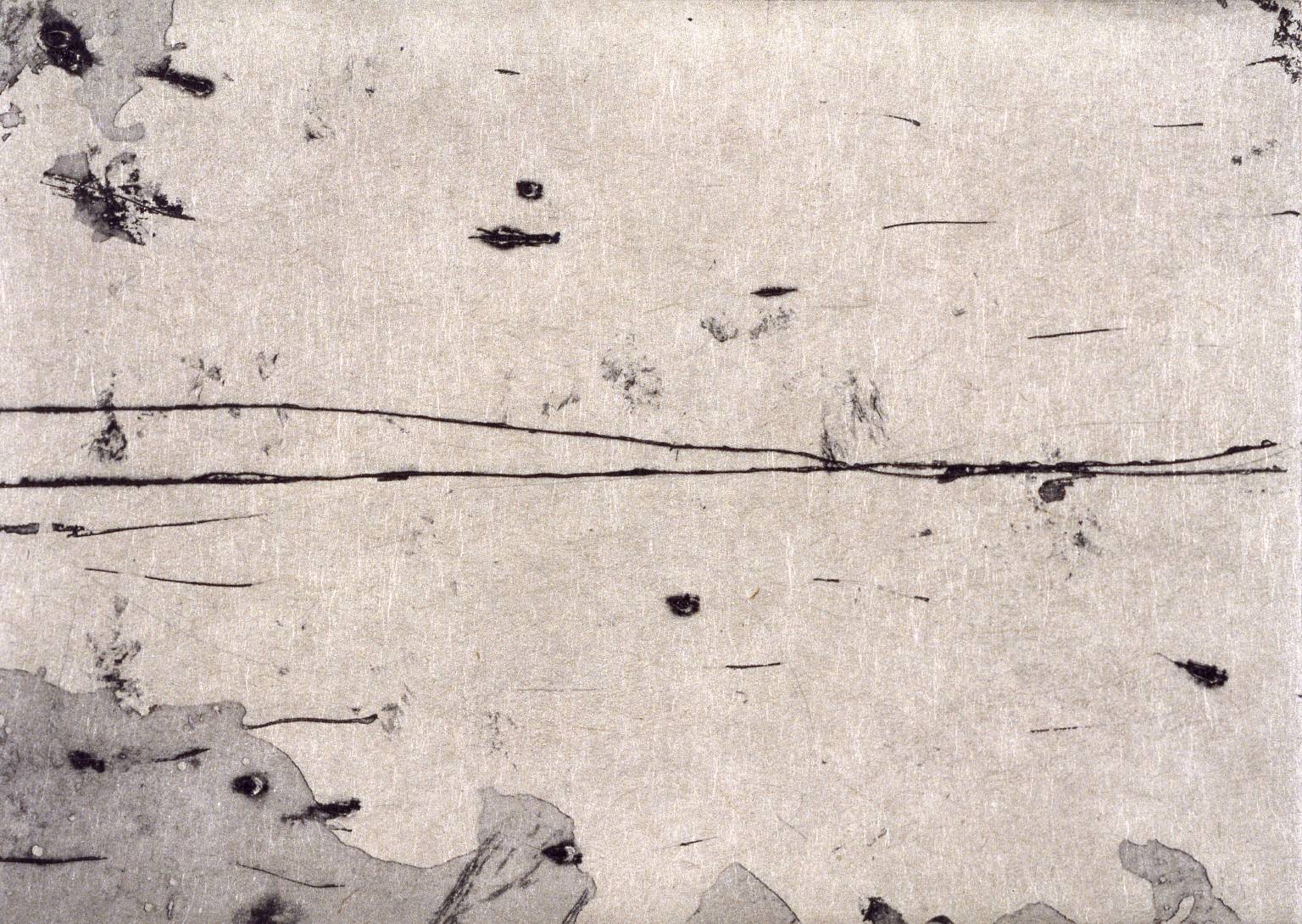
Jannis Kounellis, [no title] 1999
This etching is part of a portfolio of twelve abstract prints in an edition of twenty-one, of which this set is number twenty. Numbers one to ten have been bound; eleven to twenty-one are boxed loose portfolios. There are also five sets of artist's proofs. This text discusses the group of twelve works (P78423-P78434) as a whole. The plates were made in January 1999 in Kounellis' Roman studio using techniques which include softground etching, drypoint and aquatint as well as materials familiar from other areas of Kounellis' work, such as molten lead and wax, human hair, broken glass, coal and salt. The result is a series of twelve small, seductive abstract images, where delicate aquatinting is combined with marks, slashes, lumps and sharp lines which hint at the materials used (very literally in the case of P78433, where the artist has written the word 'piombo' - 'lead' - to indicate the nature of the abstract splotches above it) or, occasionally, at their maker (whose fingerprints can be seen on P78430 and P78434). The etchings were printed by the publisher, Jacob Samuel of Santa Monica, California, on Fabriano Tiepolo paper and natural Gampi. Gampi is a very fine Japanese paper which is placed between paper and plate at the time of printing and gives a rich, translucent finish to the resulting image. A short text by the artist prefaces the portfolio. Originally published in the journal Domus in 1982, it is repeated here in two languages, Italian and English, and describes an artist explaining to a jury his reasons for moving a figure from an unspecified print by Giovanni Battista Piranesi (1720-1778, the eighteenth-century Italian artist famous for his architectural engravings which depicted views of Rome) from the background to the foreground without changing the landscape. There follows a discussion about language, which has shifted from universal to a de-centred status, and the artist's need for a language which would allow him to enlarge the figure, in spite of his friends' warning that this would constitute an 'eversive act'. A courtroom verdict, given in the final lines of the text, finds the transgressor condemned to the life of a 'Wandering Jew', although the last line is given to the voice of a 'little old woman' who encourages the artist in his search which, she assures him, is 'the road to glory'. There appears to be no close connection between the text and the images. Giorgia BottinelliJanuary 2002 Further reading:Jannis Kounellis, 'Kounellis Brought to Trial', Domus, no.628, May 1982, pp.84-5.
15/29
artworks in ARTIST ROOMS: Jannis Kounellis
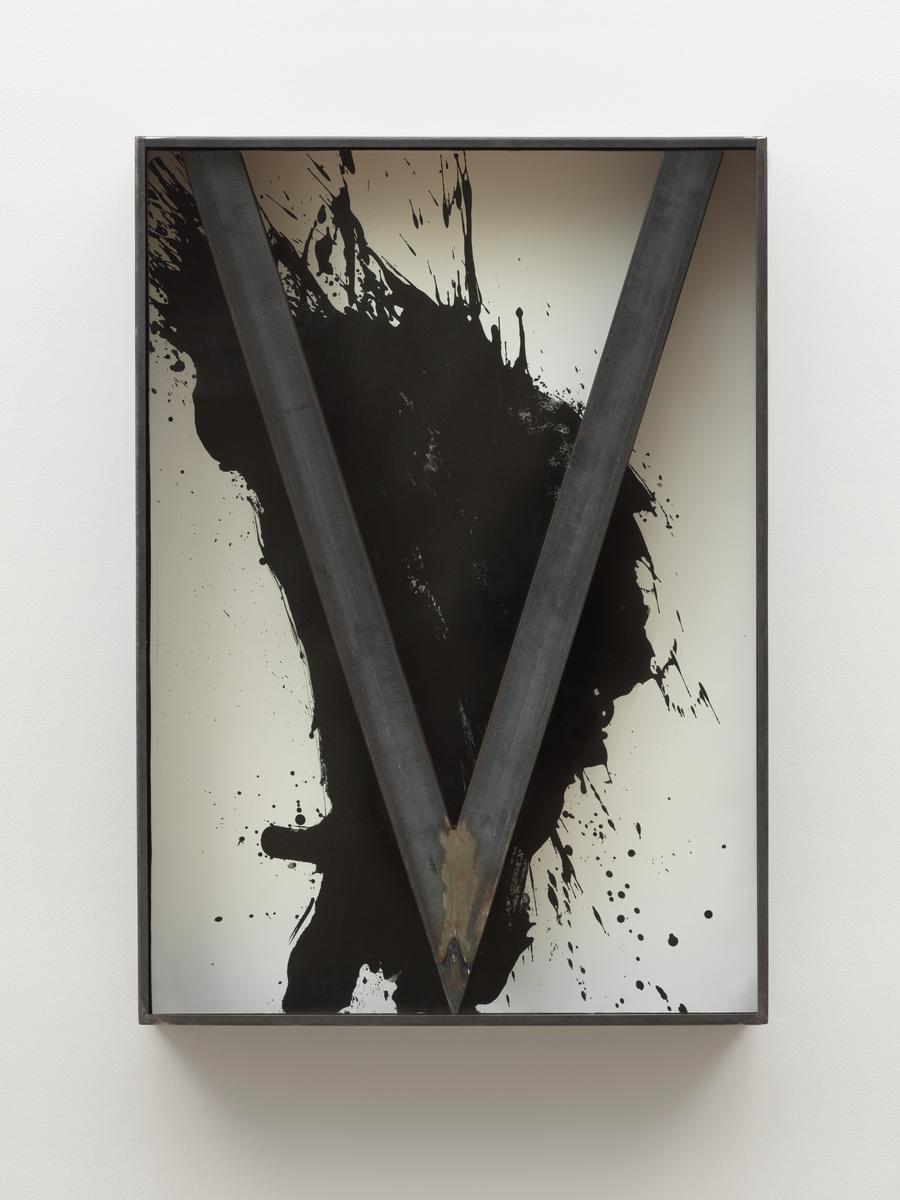
Jannis Kounellis, Untitled 2005
Untitled 2005 is a wall-mounted glass-fronted rectangular steel box. The box is lined with a monochrome lithograph, overlaid by a central metal ‘V’ shape, the extremities of which touch the top and bottom of the box. The lithograph, printed on handmade white paper, features a black paint splash. The ‘V’ is made of two I-beams, welded together at the lower point and bolted in position to the back of the metal box. From 1989 to 2005 Kounellis made a series of works produced in editions, described as multiples, in which he incorporated elements drawn from the vocabulary of his earlier practice. Untitled 2005 is one of these multiples, and is number eleven of an edition of twenty-five.
16/29
artworks in ARTIST ROOMS: Jannis Kounellis
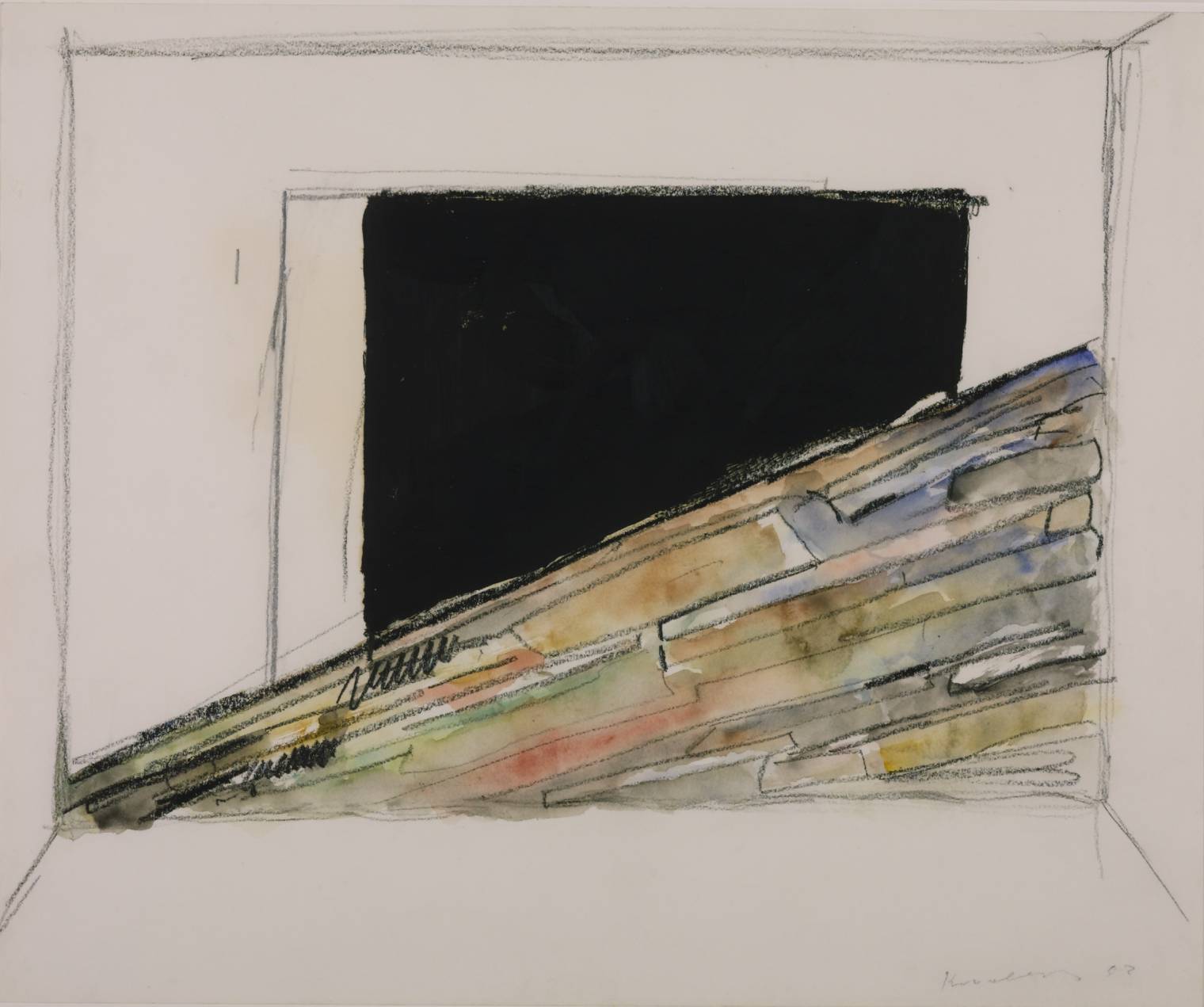
Jannis Kounellis, Untitled 1983
17/29
artworks in ARTIST ROOMS: Jannis Kounellis
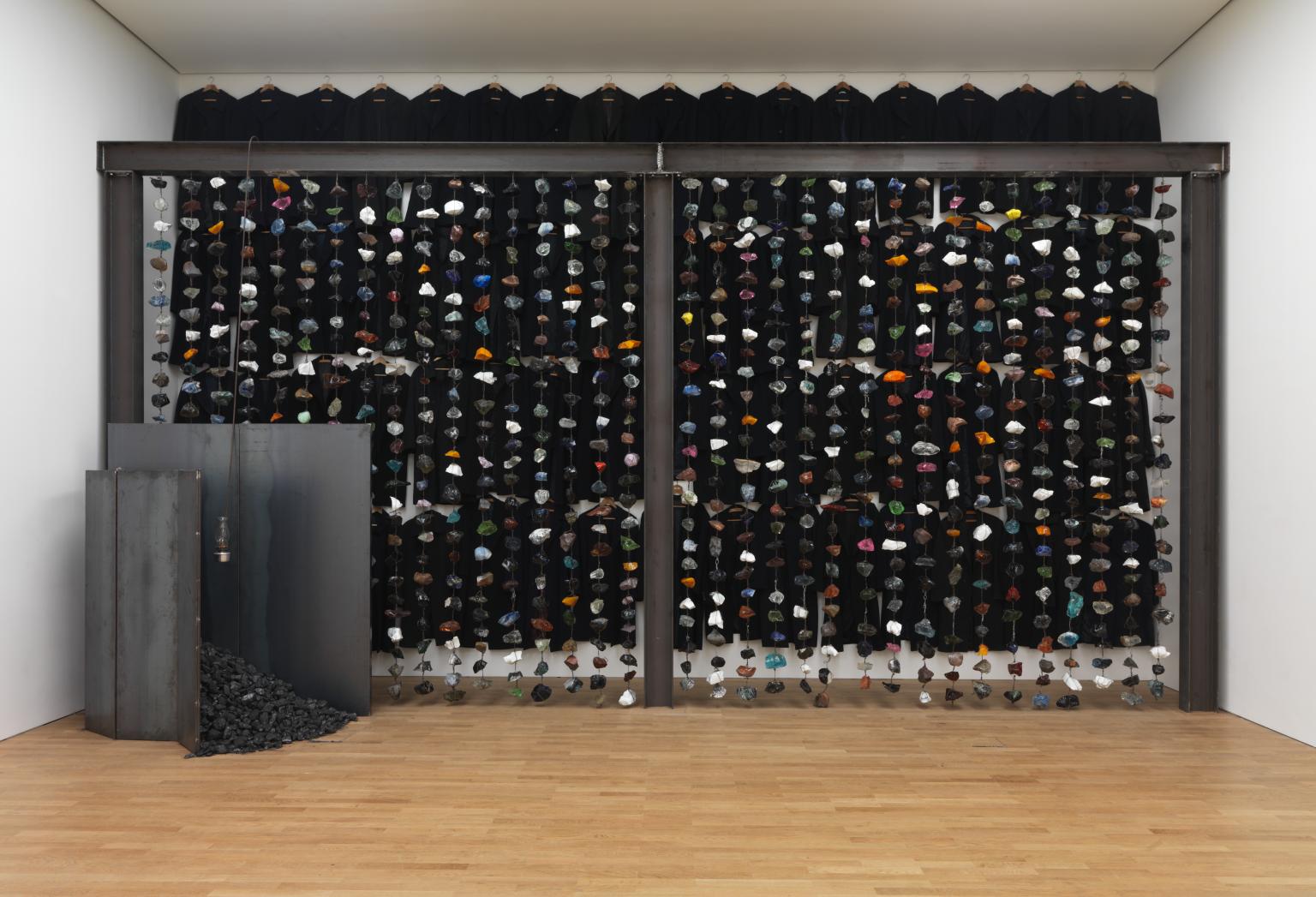
Jannis Kounellis, Coal Sculpture with Wall of Coloured Glass 1990–2005
Coal Sculpture with Wall of Coloured Glass 1990–2005 is an installation made up of two constituent parts: a screen made of glass pieces and a coal store made of steel. The screen is comprised of a steel frame from which hangs a curtain of jagged glass lumps in many colours, threaded onto thirty-four vertical wires. Each wire holds about twenty to twenty-five pieces of glass. In front of the screen, on the left hand side, is a coal store made of rolled steel, in which there is a pile of black coal that spills out slightly onto the floor. Hanging above the pile of coal from a hooked steel rod is an unlit paraffin lamp. The lamp has a bulbous crystal glass lantern with a crenulated rim.
18/29
artworks in ARTIST ROOMS: Jannis Kounellis
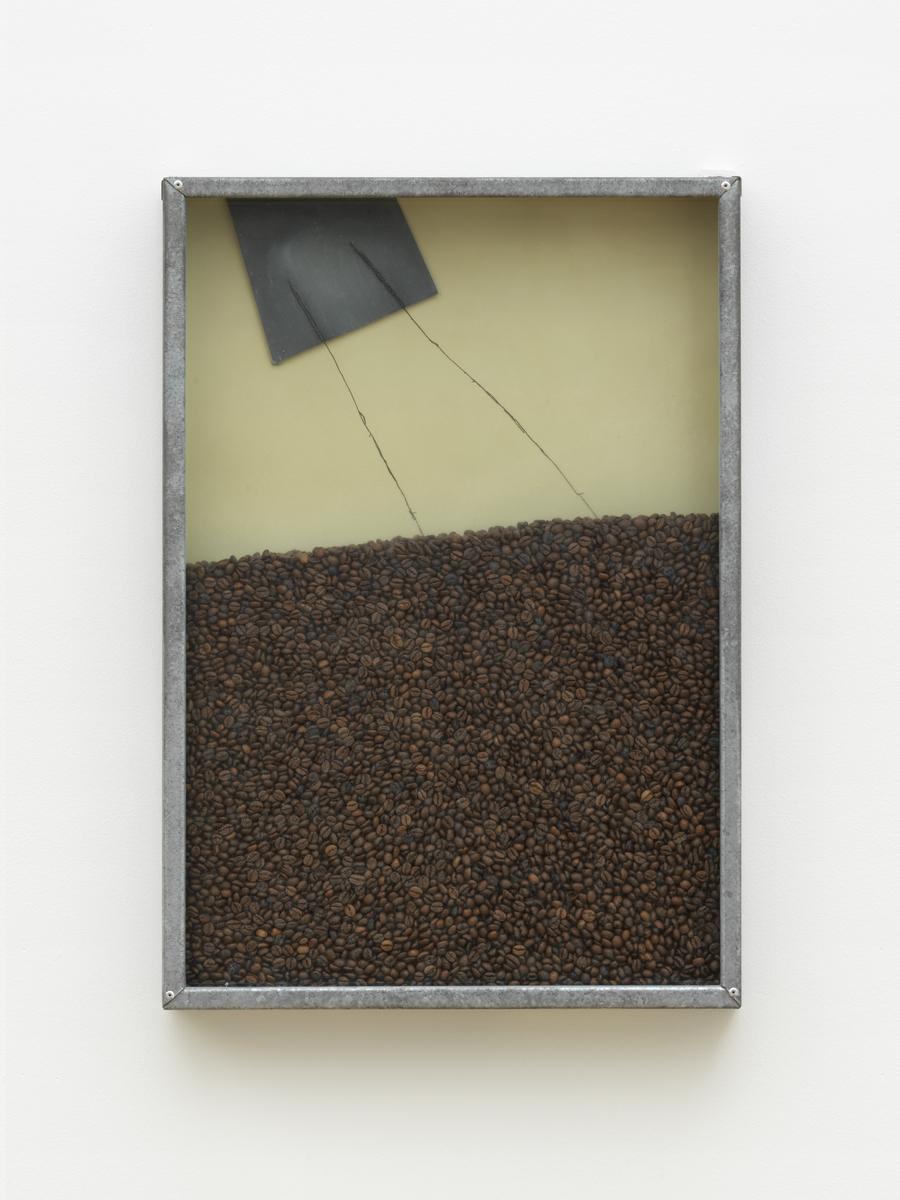
Jannis Kounellis, Untitled (Coffee) 1989–91
Untitled (Coffee) 1989–91 is a wall-mounted work consisting of a rectangular glass-fronted box half-filled with coffee beans. The back panel of this steel box is mounted with off-white paper to which a small sheet of lead is affixed at the top left-hand corner. Two dark lines are etched from the centre of the lead, marking a diagonal course downwards to the right until they meet the slope of the coffee beans. From 1989 to 2005 Kounellis made a series of works produced in editions, described as multiples, in which he incorporated elements drawn from the vocabulary of his earlier practice. Untitled (Coffee) is one of these multiples, produced in an edition of twenty-five.
19/29
artworks in ARTIST ROOMS: Jannis Kounellis

Jannis Kounellis, Untitled (Sack with Z) 2001
Untitled (Sack with Z) 2001 is a mesh-fronted, shallow metal box containing a jute sack filled with coal. On the front of the sack a large letter ‘Z’ is printed in black paint. The sack takes up three-quarters of the space within the box, and the top of the sack is slightly rolled back so that some of the coal is visible. From 1989 to 2005 Kounellis made a series of works produced in editions, described as multiples, in which he incorporated elements drawn from the vocabulary of his earlier practice. Untitled (Sack with Z) is one of these multiples, produced in an edition of twenty-five.
20/29
artworks in ARTIST ROOMS: Jannis Kounellis

Jannis Kounellis, Untitled (Scissors) 2004
Untitled (Scissors) 2004 is a wall-mounted work consisting of a portrait-orientated rectangular box made of folded and welded sheet steel with a glass front. In the lower third of the box is a pile of eighteen pairs of chromed tailor’s scissors. The scissors are arranged in two fairly even stacks, with their handles facing towards the outer edges of the box, though a couple of pairs seem to have tumbled from one of the piles. In the upper part of the box a sheet of deep red handmade glass is fixed in place on a metal shelf above the scissors. The red glass takes up most of the upper two thirds of the box and appears flecked and uneven. From 1989 to 2005 Kounellis made a series of works produced in editions, described as multiples, in which he incorporated elements drawn from the vocabulary of his earlier practice. Untitled (Scissors) is one of these multiples, and is number two of an edition of twenty-five.
21/29
artworks in ARTIST ROOMS: Jannis Kounellis
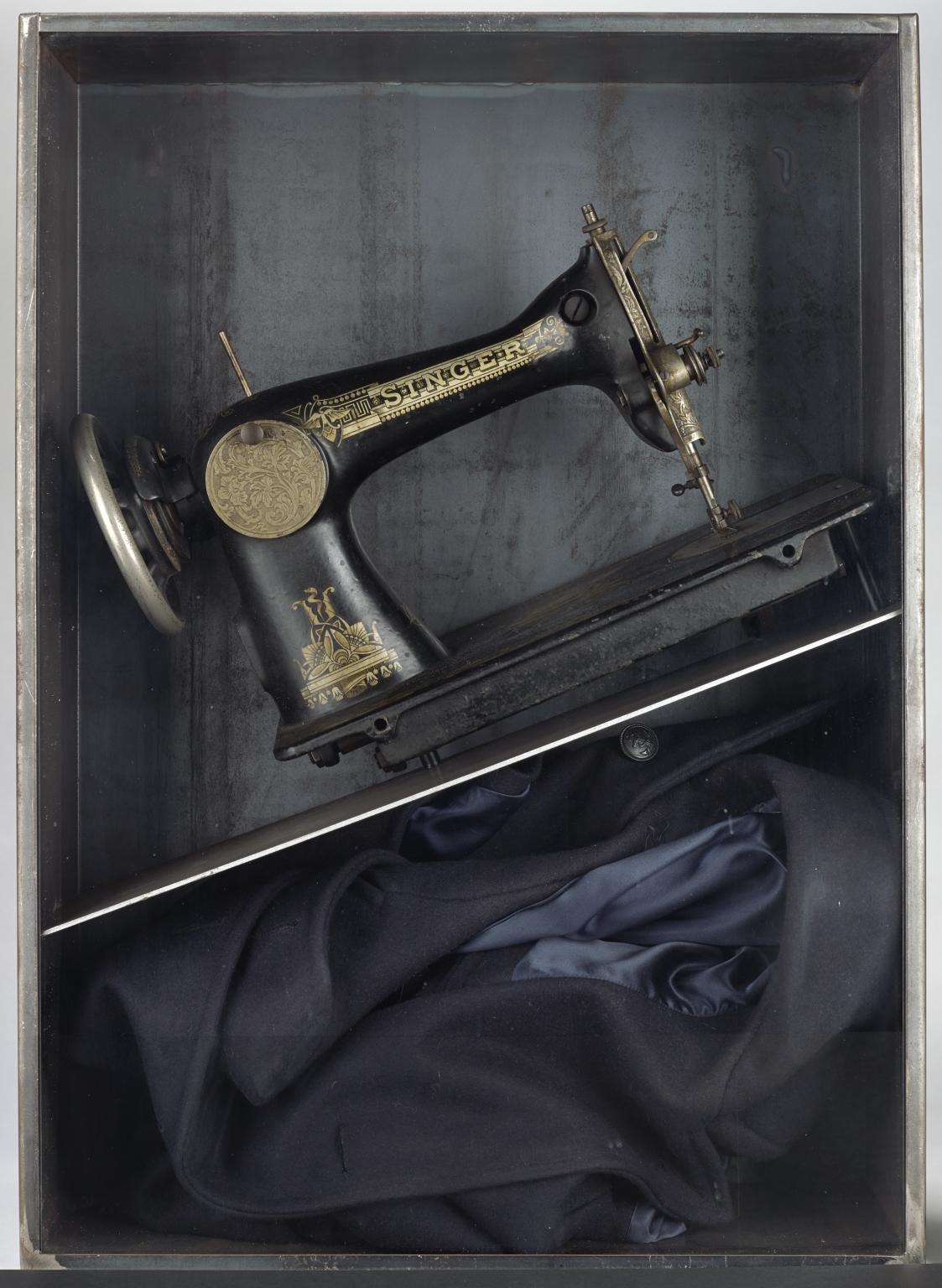
Jannis Kounellis, Untitled (Sewing Machine) 2004
Untitled (Sewing Machine) 2004 is a wall-mounted work consisting of a portrait-orientated rectangular steel box with a glass front. A steel shelf divides the vitrine, affixed diagonally going upwards from left to right. The shelf carries an old Singer sewing machine, while below the shelf is stuffed a folded black coat with blue lining. One of the buttons of the coat is visible, and on it can be seen an anchor decoration. From 1989 to 2005 Kounellis made a series of works produced in editions, described as multiples, in which he incorporated elements drawn from the vocabulary of his earlier practice. Untitled (Sewing Machine) is one of these multiples, and is number eleven of an edition of twenty-five.
22/29
artworks in ARTIST ROOMS: Jannis Kounellis
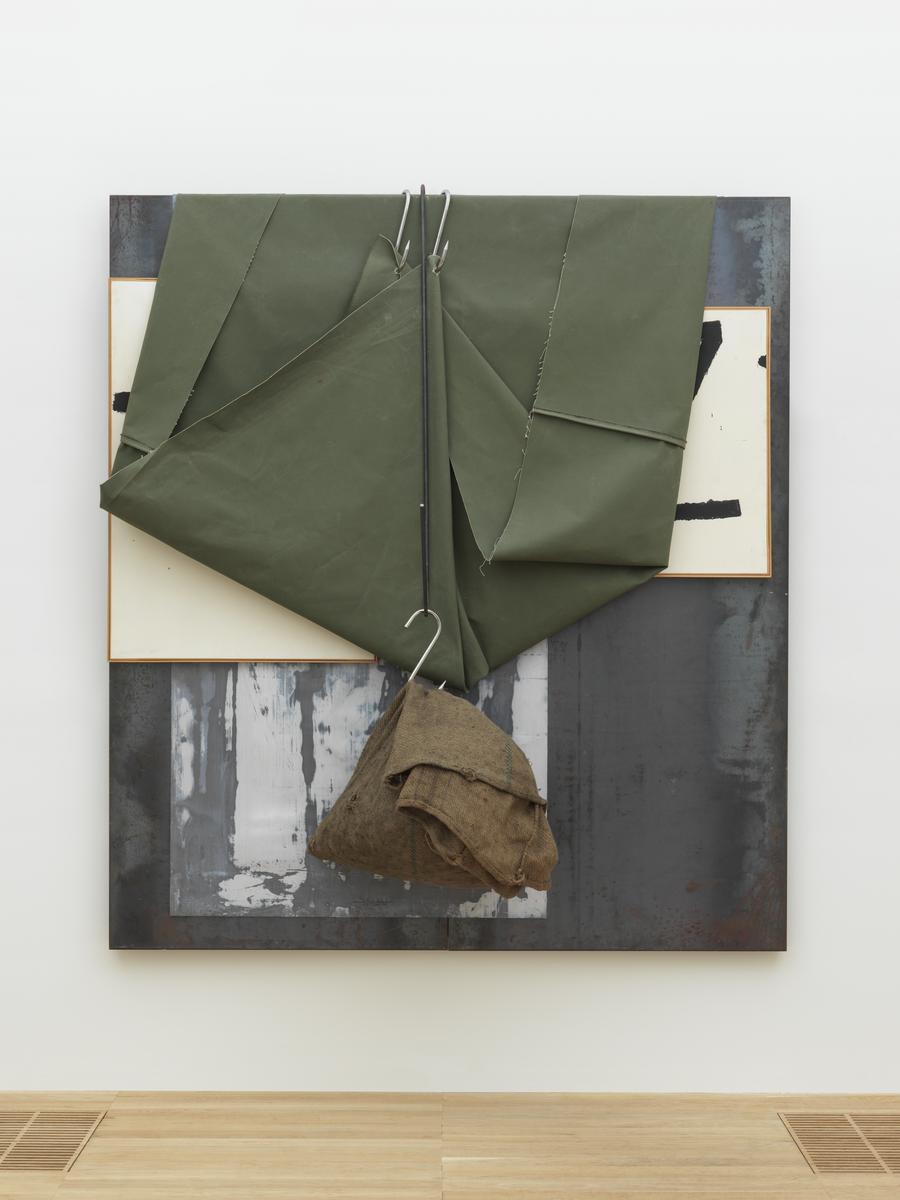
Jannis Kounellis, Untitled 1960–98
Untitled 1960-98 is a large wall-mounted work by the artist Jannis Kounellis. The work is comprised of two stretched canvases hung near the top of a flat steel panel, a portion of which is painted with enamel. These canvases are covered in off-white paper and painted with black symbols. Over the canvases is a piece of raw-edged khaki tarpaulin, folded and attached to the top of the steel panel by two S-shaped meat hooks that grip the top edge. Between these two hooks, another large metal rod hangs down, with a third S-shaped meat hook at its lower end from which hangs a jute sack full of coal. This work contains numerous elements characteristic of Kounellis’s artistic vocabulary as well as the everyday materials used in arte povera, a label the curator Germano Celant applied to the practice of many artists working in Italy in the late 1960s, including Kounellis.
23/29
artworks in ARTIST ROOMS: Jannis Kounellis

Jannis Kounellis, Bells 1993
Bells 1993 is comprised of three wooden beams, three bronze bells and several lengths of rope. Depending on the dimensions of the space in which the work is installed the beams are stacked and either wedged between two walls of the gallery or between two upright supports, allowing them to rest at a roughly twenty degree angle in relation to the floor. The lower end of the beams rests on the floor, while at the higher end, each beam has a bell attached with a knotted rope, so that the three bells hang down in a loose arrangement. Each bell has a swag decoration on the outside and elaborate filigree patterning around the middle, while the inside is plain with a clapper hanging down from the centre.
24/29
artworks in ARTIST ROOMS: Jannis Kounellis
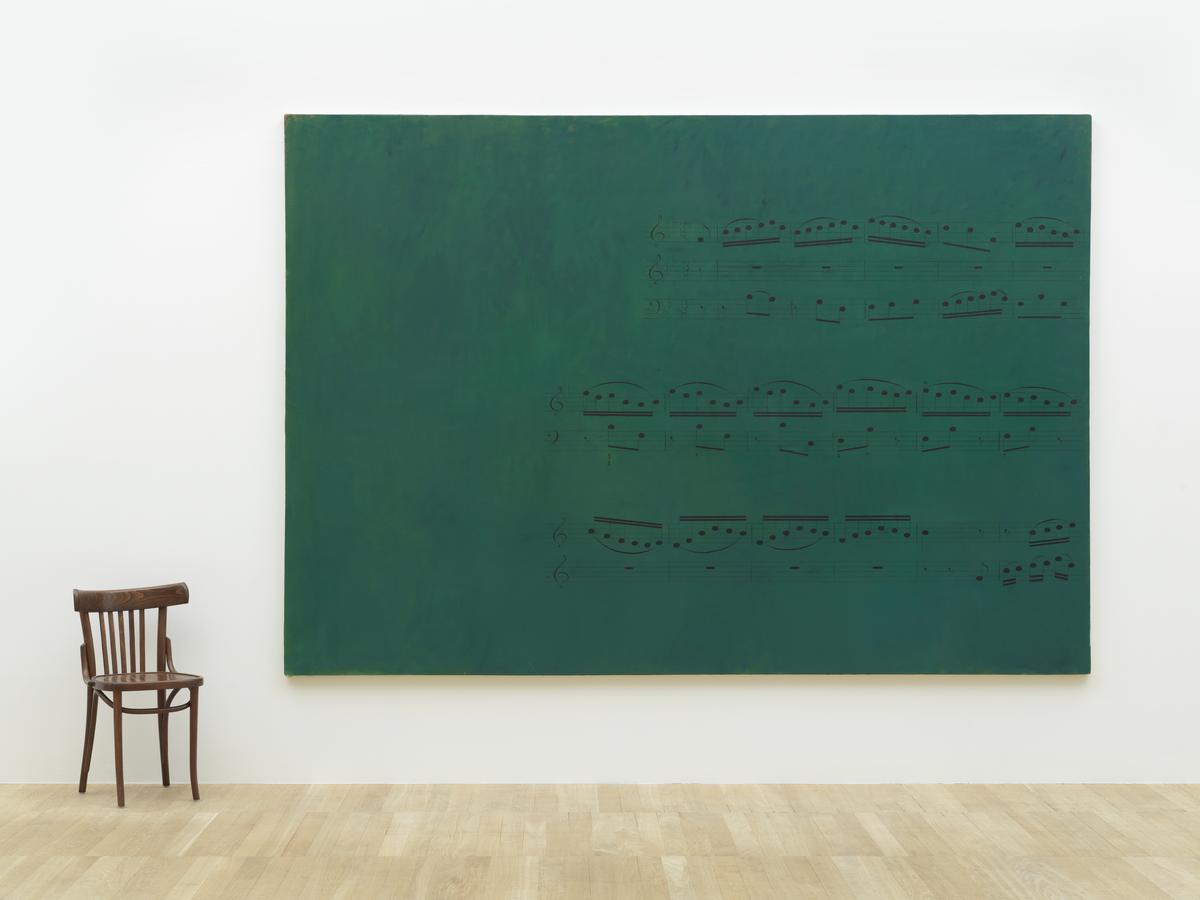
Jannis Kounellis, Untitled 1971
Untitled 1971 is a large canvas hung on the wall with a wooden chair placed on the floor to the left of the painting. The landscape-format canvas is painted a dark blue-green and marked with a fragment of musical score painted in black on the right hand side. When this work was first exhibited at the Modern Art Agency in Naples a cellist sat on the chair adjacent to the painting and repeatedly played the music shown on the canvas, a fragment of J.S. Bach’s Passion According to St John, composed in 1723–4.
25/29
artworks in ARTIST ROOMS: Jannis Kounellis

Jannis Kounellis, Untitled 1969
In one of his most physically powerful works, Kounellis blocks a doorway in the exhibition space, thereby restricting the possible access and exit points from the gallery. Like many of his contemporaries, Kounellis turned to an ancient technique in order to address current concerns. Here the traditional method is dry stone building, used most commonly to divide farmland, but also alluding to the blocked doorways of abandoned houses in the artist’s native Greece. The work draws attention to the architecture of the museum and creates a somewhat threatening environment for the spectator.
Gallery label, April 2009
26/29
artworks in ARTIST ROOMS: Jannis Kounellis
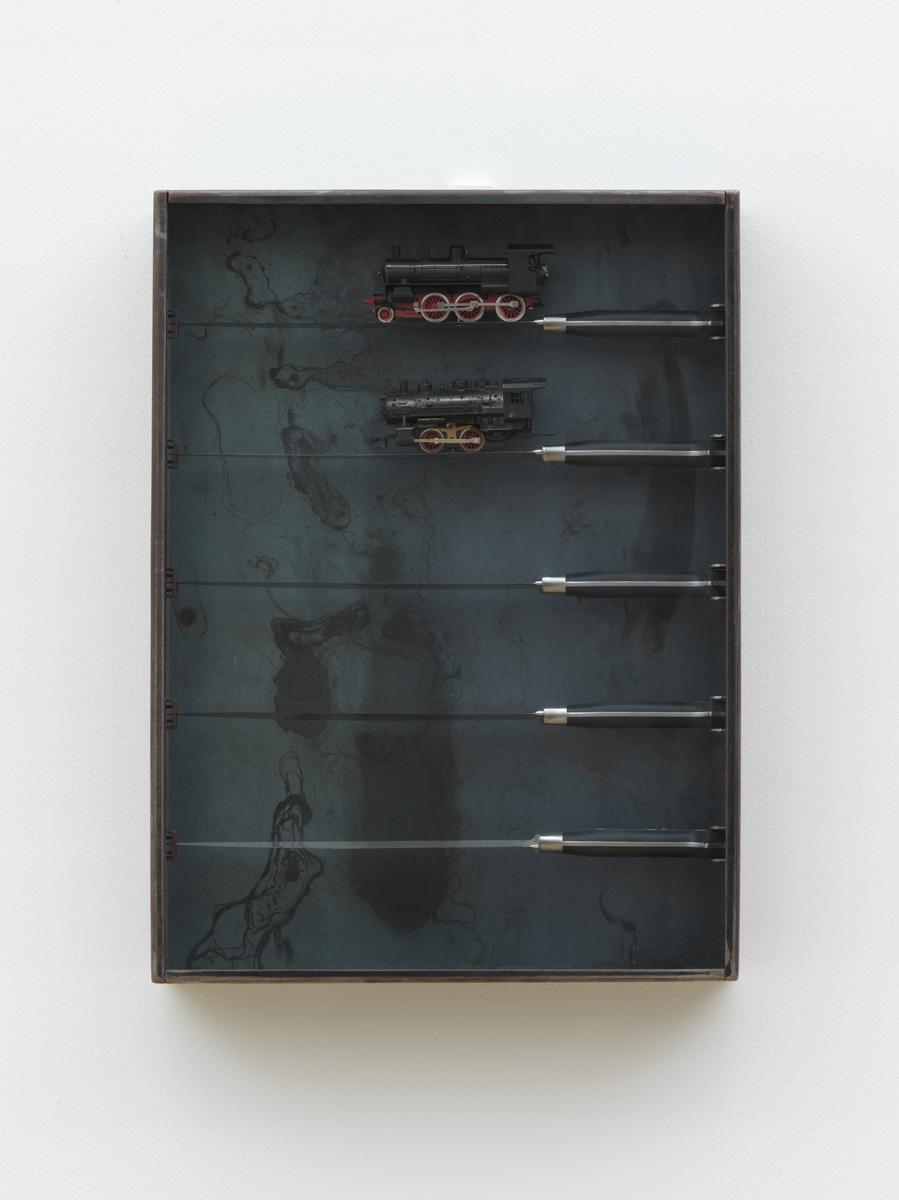
Jannis Kounellis, Untitled (Knife and Train) 2002
Untitled (Knife and Train) 2002 is a wall-mounted work consisting of a portrait-orientated rectangular steel box containing five kitchen knives and two toy train engines. The knives are regularly spaced and arranged horizontally so that the base of each handle, on the right, and the tip of each blade, on the left, touch the edges. The sharp edge of the blade faces outwards, towards the viewer. The top two blades act as shelves for two 00 gauge toy train engines. The box is glass-fronted with a water-marked interior. From 1989 to 2005 Kounellis made a series of works produced in editions, described as multiples, in which he incorporated elements drawn from the vocabulary of his earlier practice. Untitled (Knife and Train) is one of these multiples, produced in an edition of twenty-five.
27/29
artworks in ARTIST ROOMS: Jannis Kounellis
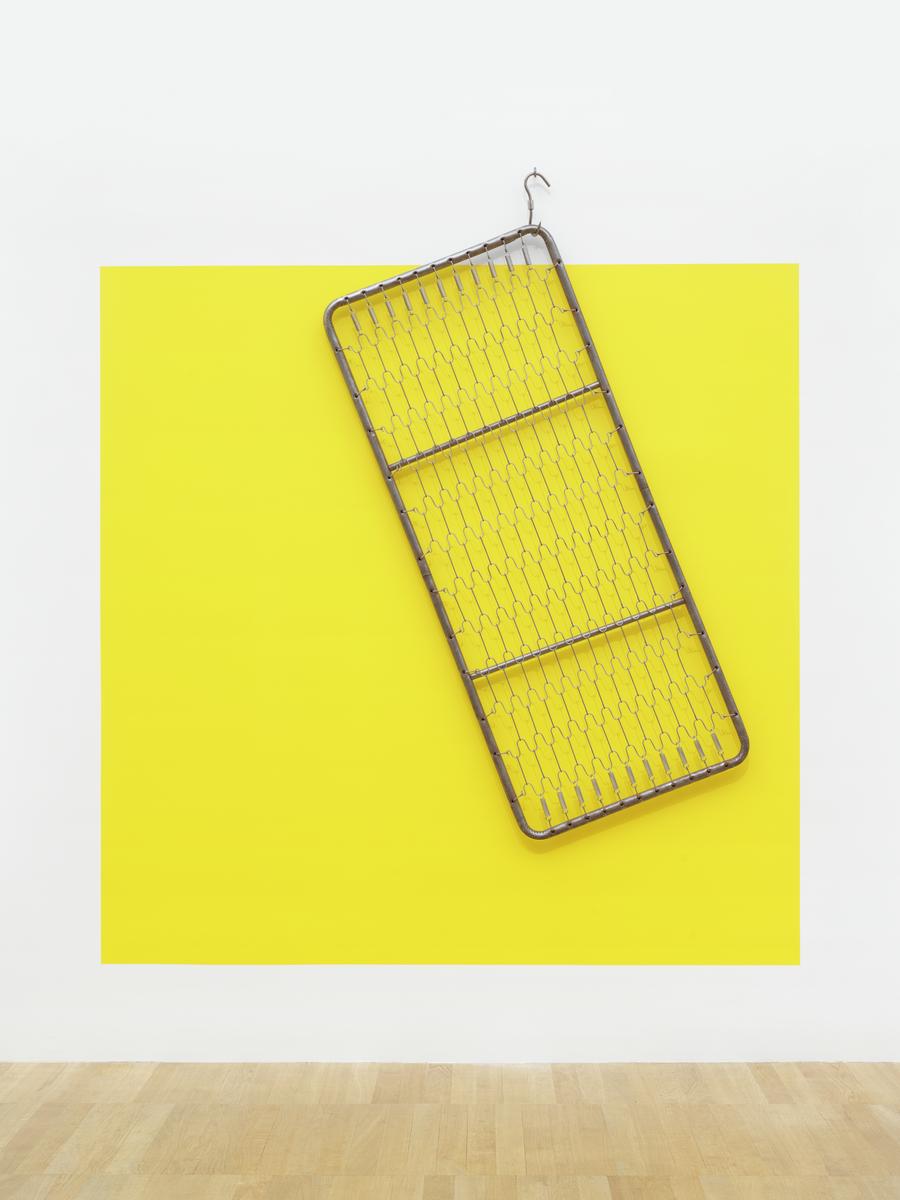
Jannis Kounellis, Untitled 1993
Untitled 1993 consists of two parts: a dandelion yellow square painted directly onto the gallery wall, and a brushed steel rectangular bed frame with tight, twisted springs. The yellow painting is over two metres square and sits thirty centimetres above the floor. The bedframe hangs by its top right-hand corner from a swivel hook placed a little above the painted square. As such it sits at an angle to the perpendicular lines of the yellow surface. The volume and weight of the bedframe contrast with the flatness of the painted surface.
28/29
artworks in ARTIST ROOMS: Jannis Kounellis
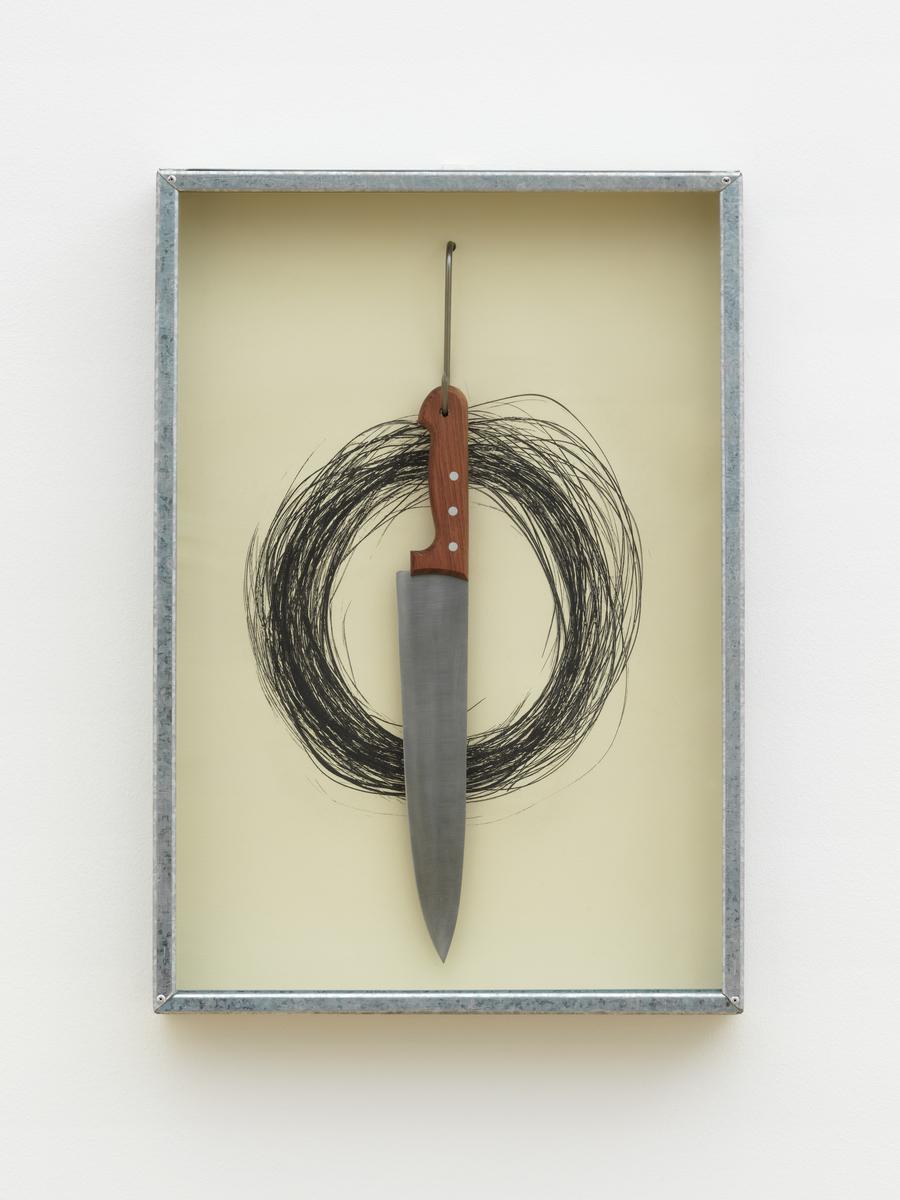
Jannis Kounellis, Untitled (Hanging Knife) 1991
Untitled (Hanging Knife) 1991 consists of several objects arranged within a wall-mounted shallow box. The portrait-orientated box is made of galvanised steel and is glass-fronted. The back of the box is lined with a sheet of handmade paper on which there is an etching in black ink of a circle formed of many loosely drawn lines. The paper has two raw edges, at the sides, and two cut edges, at the top and bottom. It is pierced near the top, in the centre, by an S-shaped butcher’s hook. From this hook a sharp cook’s knife hangs down vertically by a hole in its red hardwood handle. The knife has a riveted steel blade with ROSTFREI etched on the reverse (facing the paper). From 1989 to 2005 Kounellis made a series of works produced in editions, described as multiples, in which he incorporated elements drawn from the vocabulary of his earlier practice. Untitled (Hanging Knife) is one of these multiples, and is number ten of an edition of twenty-five.
29/29
artworks in ARTIST ROOMS: Jannis Kounellis
Art in this room


![P78431: [no title]](https://media.tate.org.uk/art/images/work/P/P78/P78431_10.jpg)
![P78434: [no title]](https://media.tate.org.uk/art/images/work/P/P78/P78434_10.jpg)
![P78423: [no title]](https://media.tate.org.uk/art/images/work/P/P78/P78423_10.jpg)
![P78424: [no title]](https://media.tate.org.uk/art/images/work/P/P78/P78424_10.jpg)
![P78425: [no title]](https://media.tate.org.uk/art/images/work/P/P78/P78425_10.jpg)
![P78426: [no title]](https://media.tate.org.uk/art/images/work/P/P78/P78426_10.jpg)
![P78427: [no title]](https://media.tate.org.uk/art/images/work/P/P78/P78427_10.jpg)
![P78428: [no title]](https://media.tate.org.uk/art/images/work/P/P78/P78428_10.jpg)
![P78430: [no title]](https://media.tate.org.uk/art/images/work/P/P78/P78430_10.jpg)
![P78432: [no title]](https://media.tate.org.uk/art/images/work/P/P78/P78432_10.jpg)
![P78433: [no title]](https://media.tate.org.uk/art/images/work/P/P78/P78433_10.jpg)

![P78429: [no title]](https://media.tate.org.uk/art/images/work/P/P78/P78429_10.jpg)














You've viewed 6/29 artworks
You've viewed 29/29 artworks
